Yungang Grottoes Overview
Located in Datong city, Shanxi Province, the Yungang Grottoes are a monumental ensemble in the history of Buddhist cave art. Carved from the mid-5th to early-6th century AD, these grottoes comprise 252 caves and niches, housing an impressive collection of 51,000 statues across a carved area of 18,000 square meters. This site stands as a testament to the remarkable achievements of Buddhist art in China during the 5th and 6th centuries.
Get your dose of History via Email
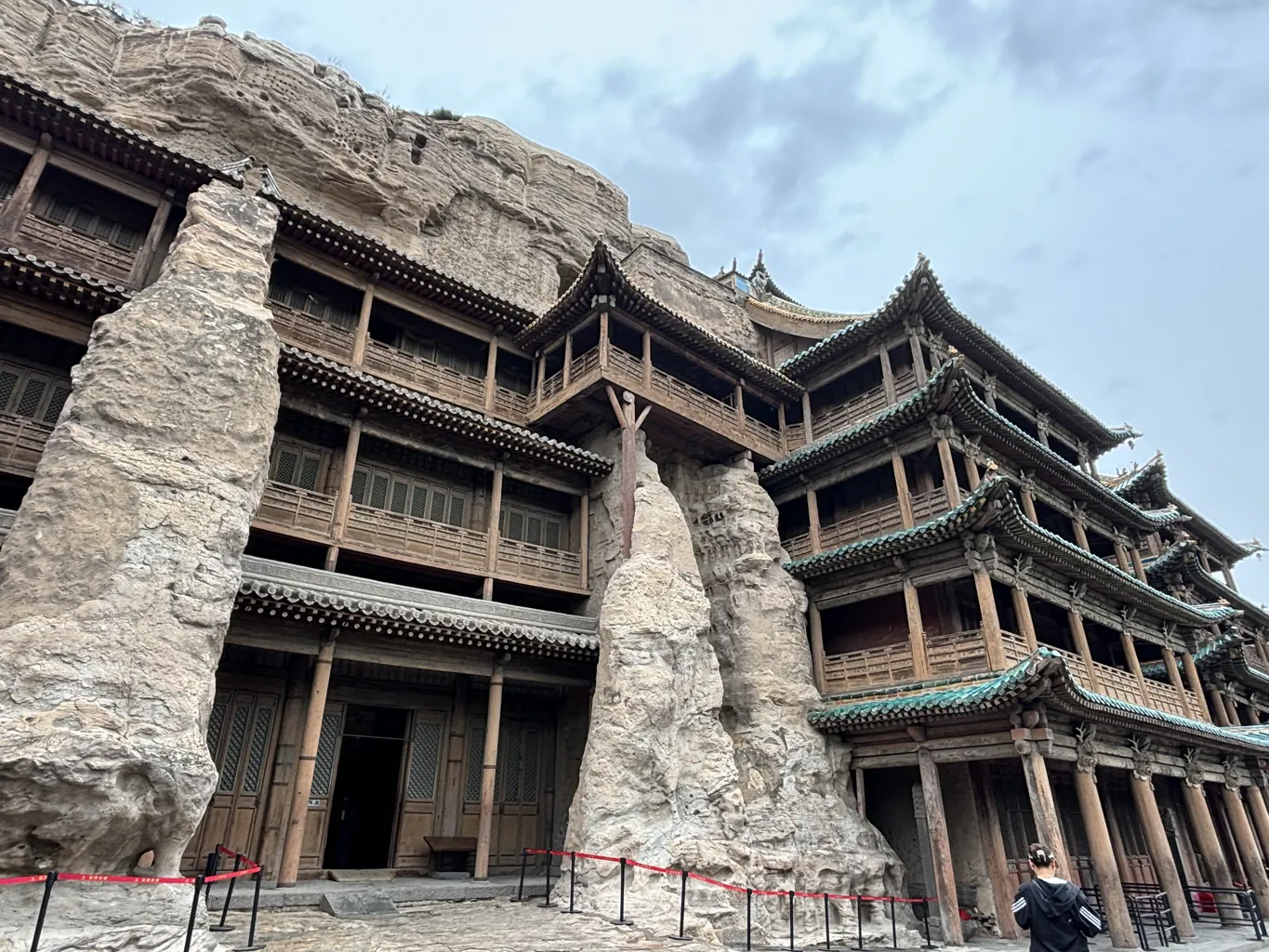
Tan Yao’s Classical Masterpiece
Among the numerous caves, the Five Caves created by Tan Yao are particularly significant. These caves are celebrated for their strict unity of layout and design, representing a classical masterpiece that marks the first peak of Chinese Buddhist art. The architectural and artistic coherence in these caves reflects a sophisticated understanding of both religious symbolism and aesthetic harmony.
Cultural Synthesis and Imperial Influence
The construction of the Yungang Grottoes was a state-sponsored project, reflecting the imperial will during the Northern Wei Dynasty. This period was marked by a profound integration of Buddhist beliefs into Chinese culture, influenced by earlier Buddhist cave art from South and Central Asia. However, the Yungang Grottoes distinguish themselves by incorporating a distinctive Chinese character and local spirit, thus interpreting Buddhist art in a manner unique to this region.
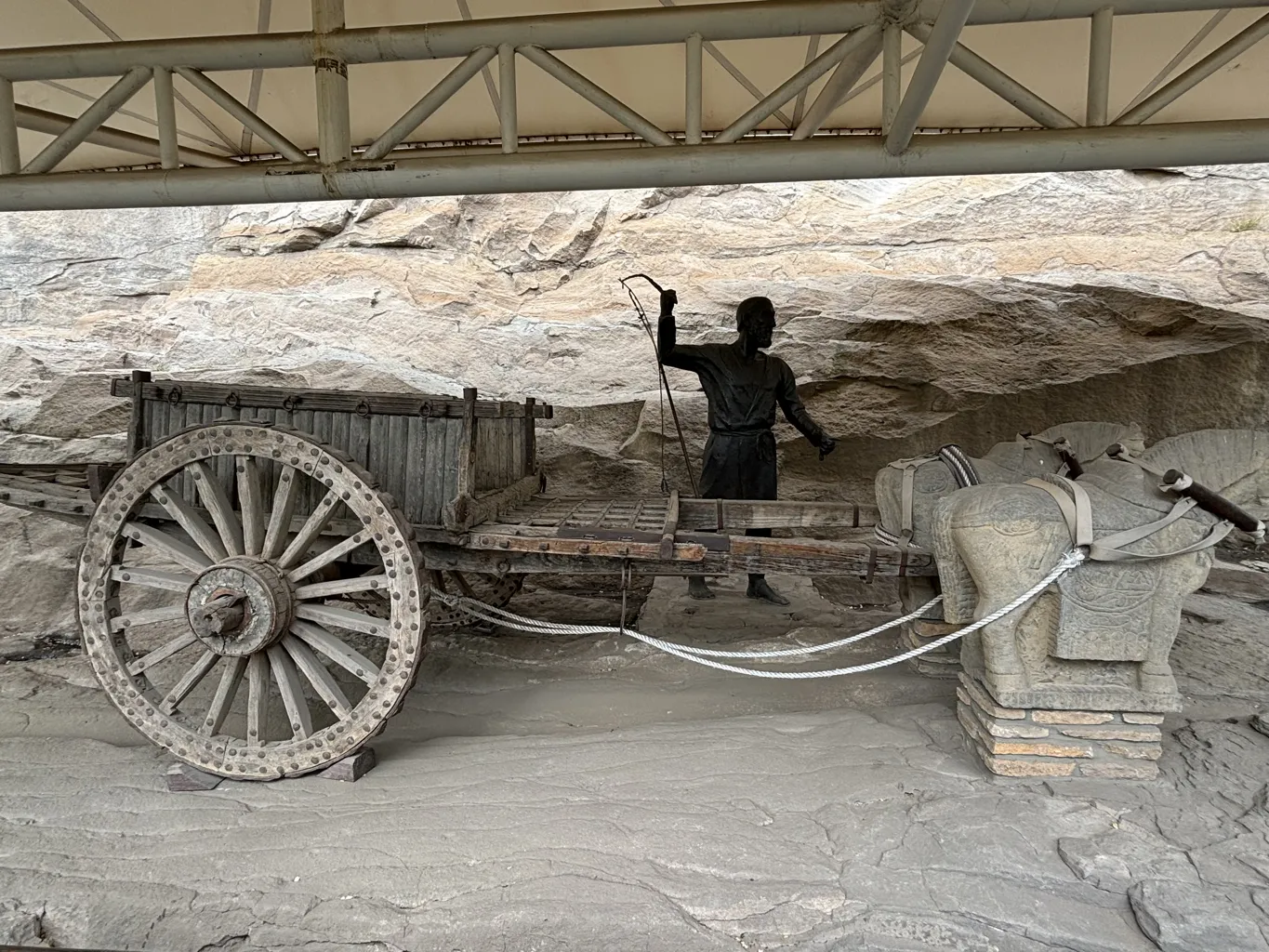
Impact and Legacy
The Yungang Grottoes have not only enriched the cultural landscape of China but have also had a far-reaching impact on the development of Buddhist cave art across East Asia. Their influence is evident in the subsequent artistic endeavors in the region, where the fusion of foreign styles with local traditions continued to evolve. The grottoes play a crucial role among the early Oriental Buddhist grottoes, serving as a pivotal point in the historical and artistic dialogue between different cultures.
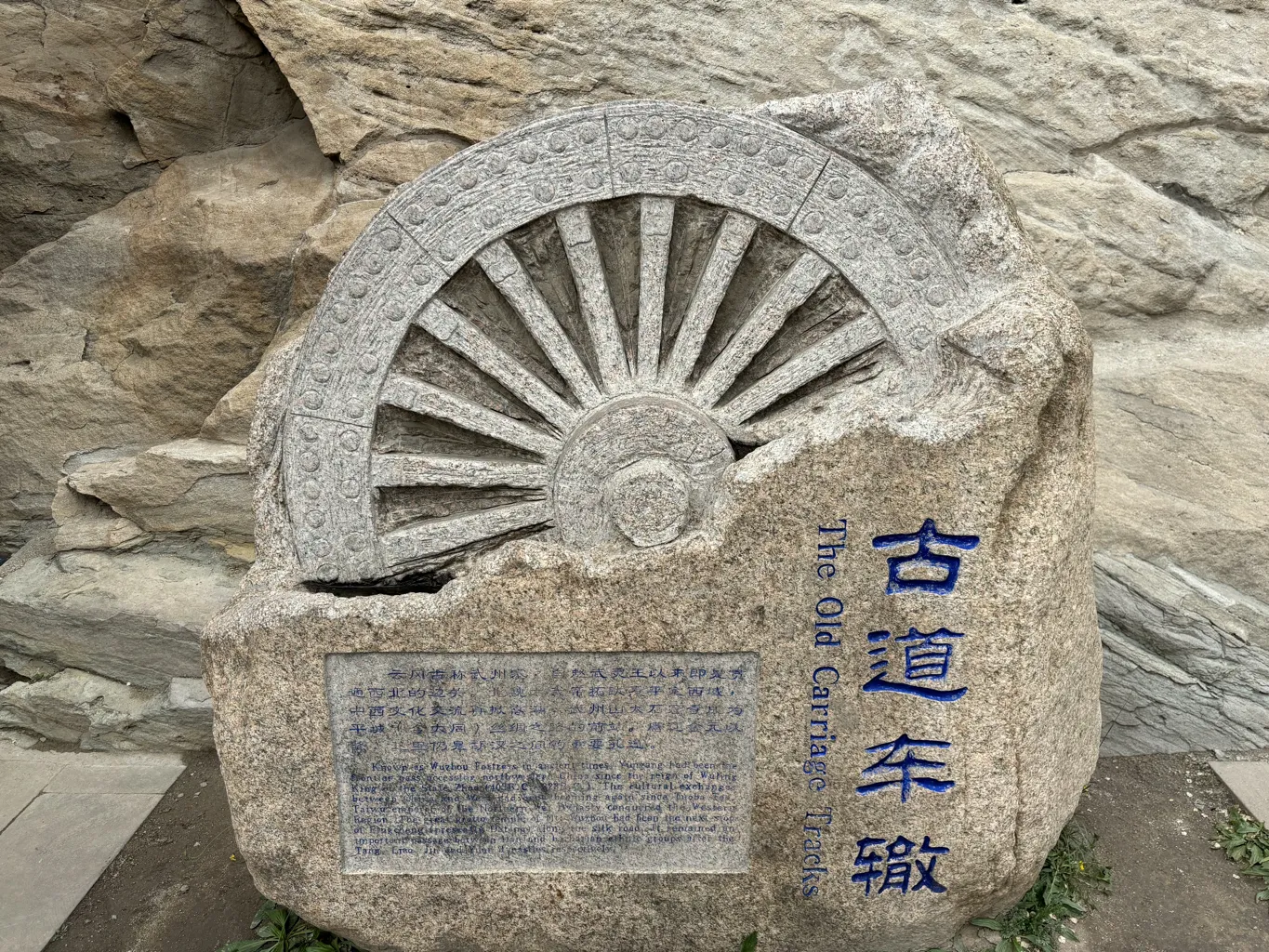
Detailed Exploration of Select Caves at Yungang Grottoes
In this section, we delve into the specifics of 20 out of the 252 caves and niches at the Yungang Grottoes, highlighting their unique contents, historical significance, and the artistic marvels they house.
Otone Drum Cave (Cave No. 1)
Otone Drum Cave, also known as Cave No. 1, dates back to the period between 471 and 494 AD. This cave, along with Cave No. 2, forms a pair of stupa shrine-type caves. Interestingly, each cave features a square pagoda on its exterior.
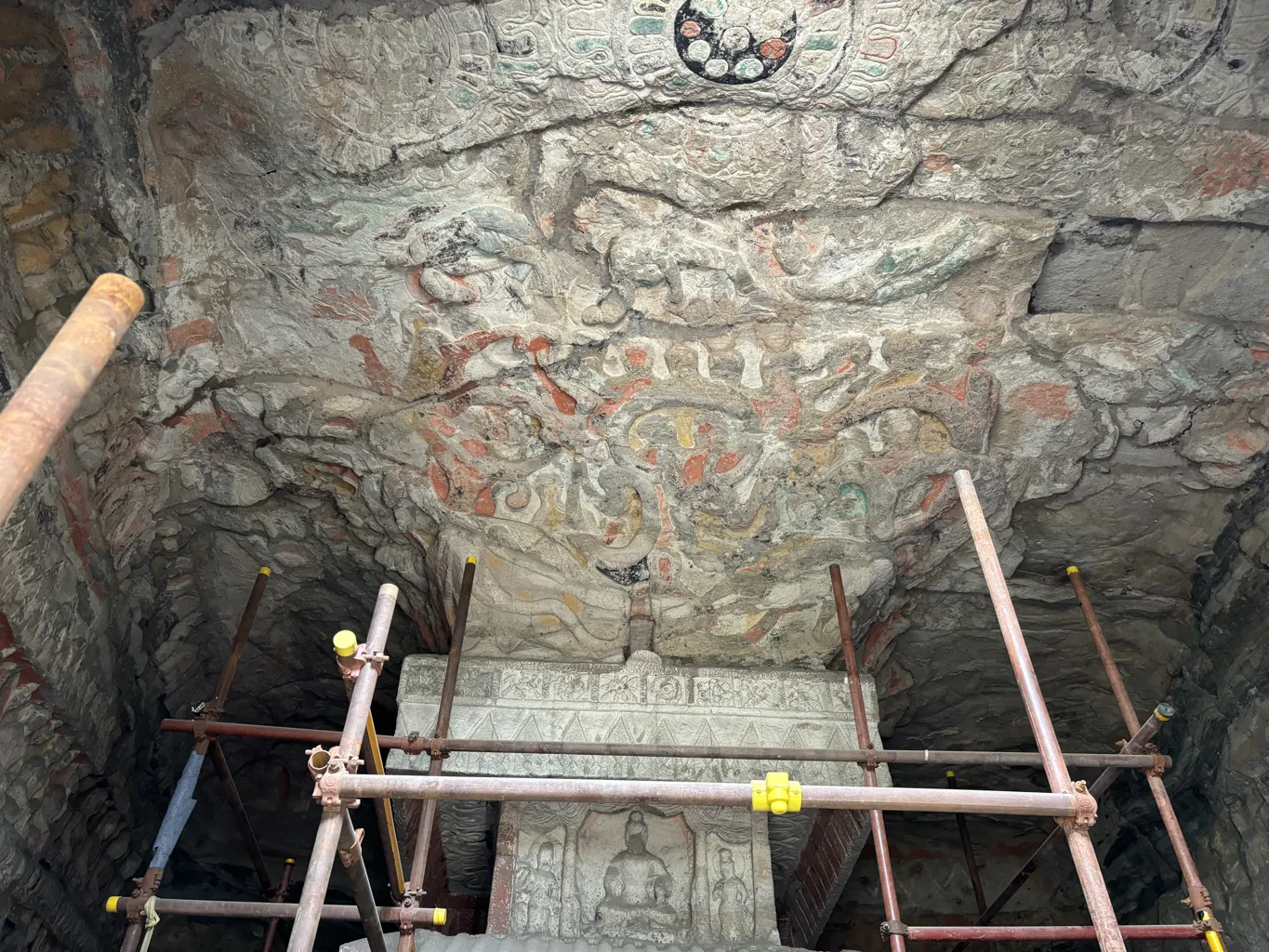
Architectural Features and Artistic Embellishments
The layout of Cave No. 1 is rectangular with a flat ceiling. The central pillar, boasting two levels, mimics the eaves of a wooden tower roof. This design choice enhances the cave’s aesthetic and structural resemblance to traditional wooden architecture.
Significant Inscriptions and Sculptures
Zhu Tinghan, a renowned Qing dynasty poet, left his mark here. His poem “Visit Yungang Grottoes” graces the eastern side of the cave’s hamming window. Moreover, the primary sculpture on the north wall depicts the crossing feet Maitreya. Additionally, the east wall features a relief depicting the Jataka story of Samaka, adding a layer of narrative depth to the cave’s artistic expressions.
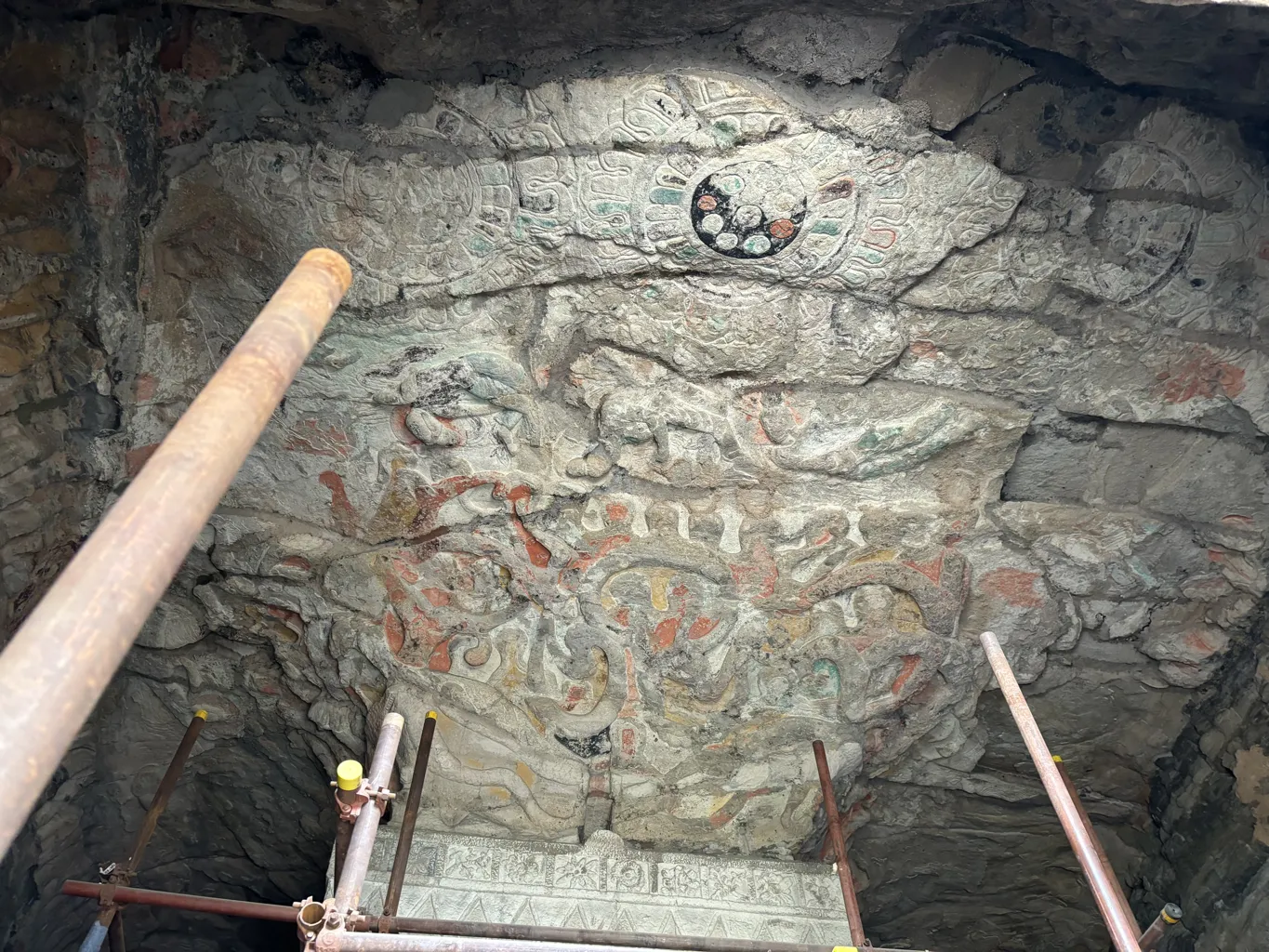
Historical Significance and Cultural Heritage
Historical research indicates that before the Liao Dynasty, Caves No. 1 and 2 were part of the Hu Guo Temple, one of the ten temples in Yungang. During the Ming and Qing dynasties, the site was known as “Stone Drum Cool Spring.” It was celebrated as one of the eight sights of Yungang, highlighting its enduring cultural and historical importance.
Cool Spring Cave (Cave No.2)
Cool Spring Cave, dating back to 471-494 AD, features remarkable inscriptions and architectural carvings. The inscriptions “landscape has clear sound” and “the deep of the cloud” adorn the top and western side of the cave’s outer hamming window. This cave showcases a central pillar designed with three levels, incorporating imitated wooden structures such as eaves ties, eave-rafters, and brackets. Additionally, the pillar features an octagonal column carved in hollow relief at each of the four upper corners.
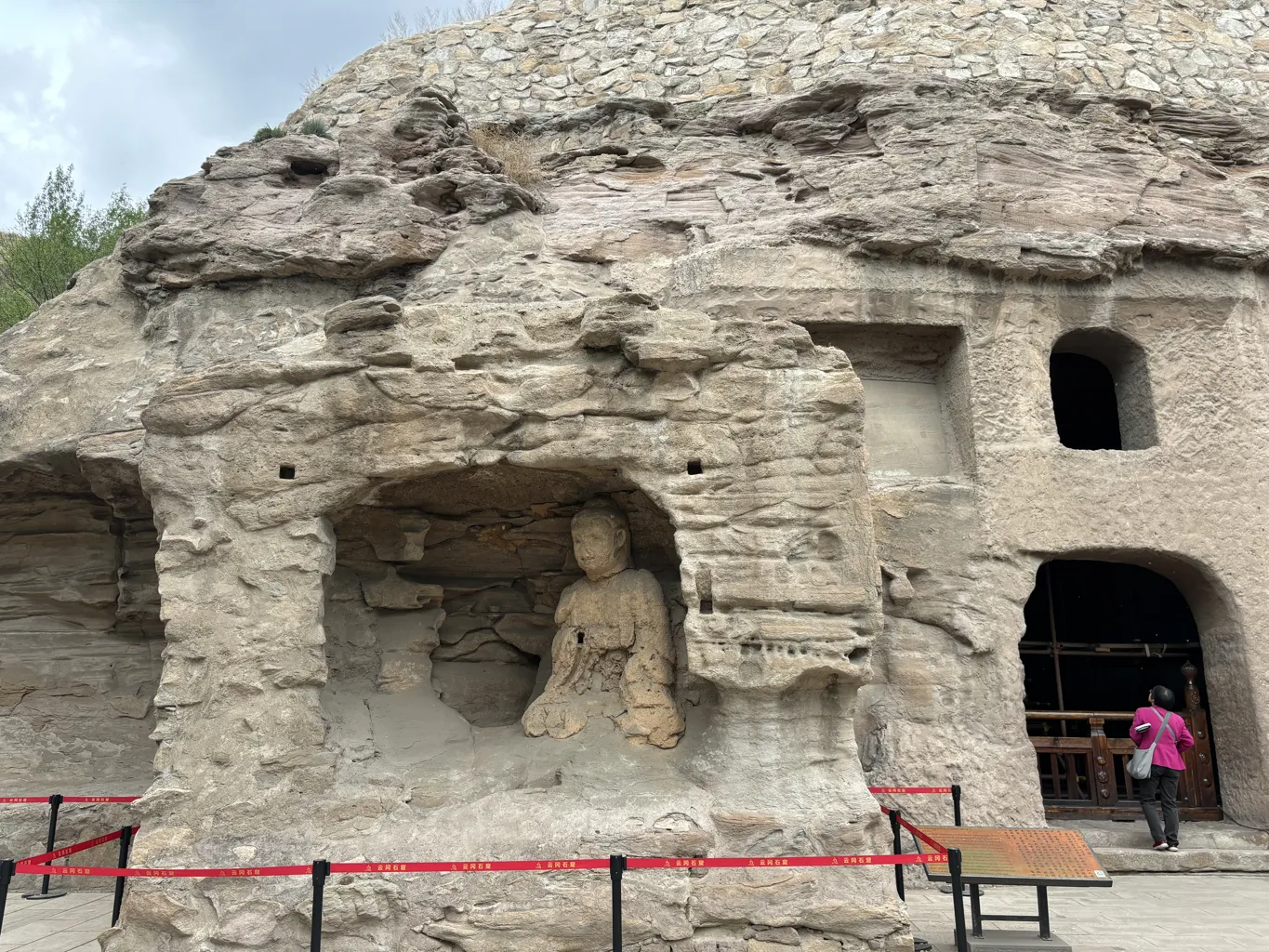
Artistic Distribution and Iconography
The cave’s four walls are evenly divided into sections. At the top, artisans carved a row of niches housing celestial musicians. Below these, rows of meditating Buddhas appear, followed by large niches with serial story carvings in relief. The bottom section prominently displays donors. The primary image, a weathered sculpture of sitting Sakyamuni, dominates the north wall. On the east wall’s base, there is a depiction of the “Arrow shoots iron drum” scene from Buddha’s life.
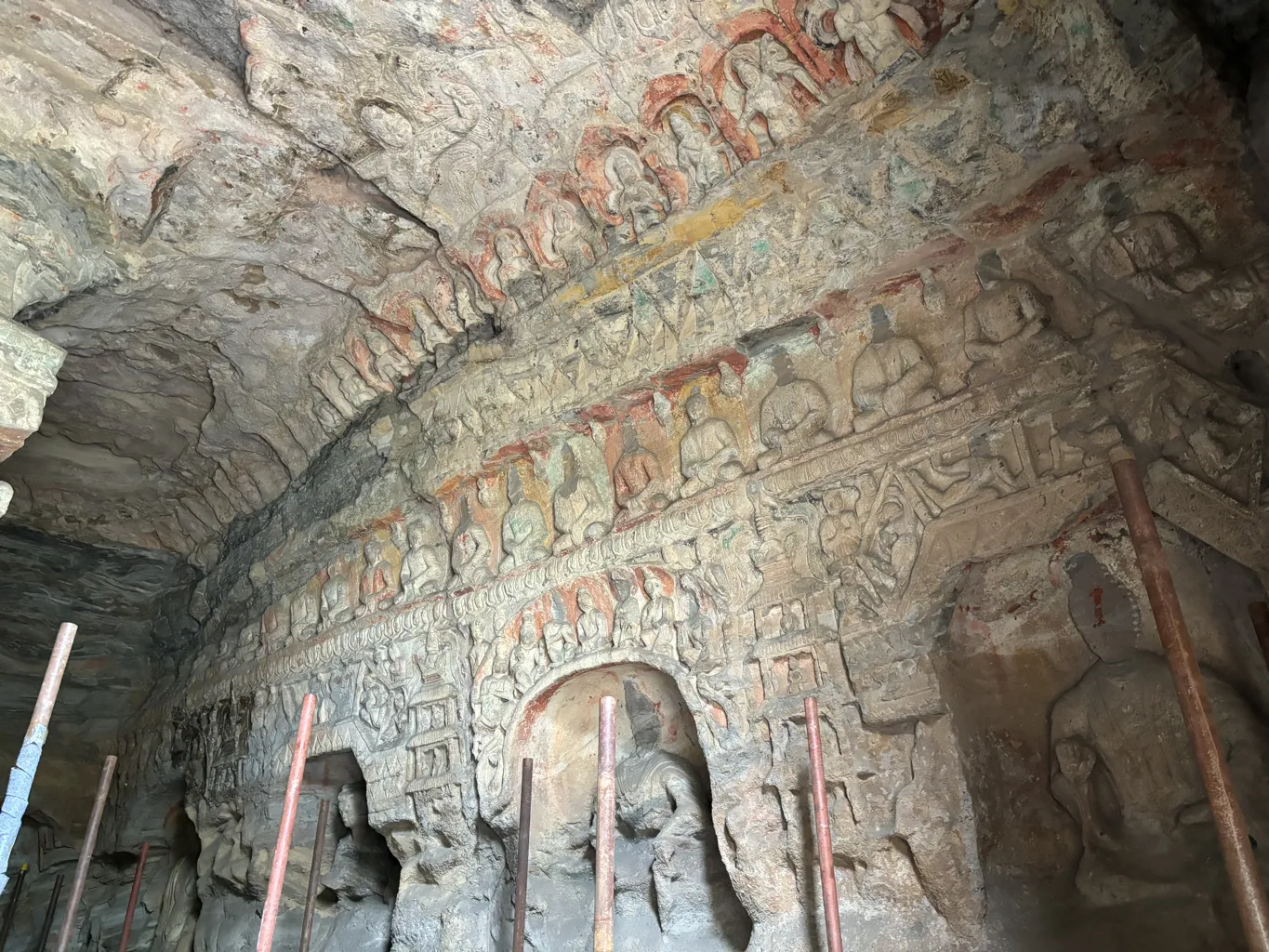
Significance of the Name
The name “Cool Spring Cave” derives from a spring that emerges from the cave’s ground, highlighting the natural features that complement its historical and cultural significance.
Ling Yan Cave (Cave No. 3)
Ling Yan Cave, also known as Cave No. 3, dates back to the period between 471 and 494 AD. This cave, located at Yungang, was initially intended to house a large pagoda. Unfortunately, the construction did not complete during the Northern Wei Dynasty. Originally, a wooden attic adorned the exterior of the cave and the cliff. Today, evidence of this structure remains in the form of 12 beam holes. These suggest that the early attic spanned 11 rooms in width.
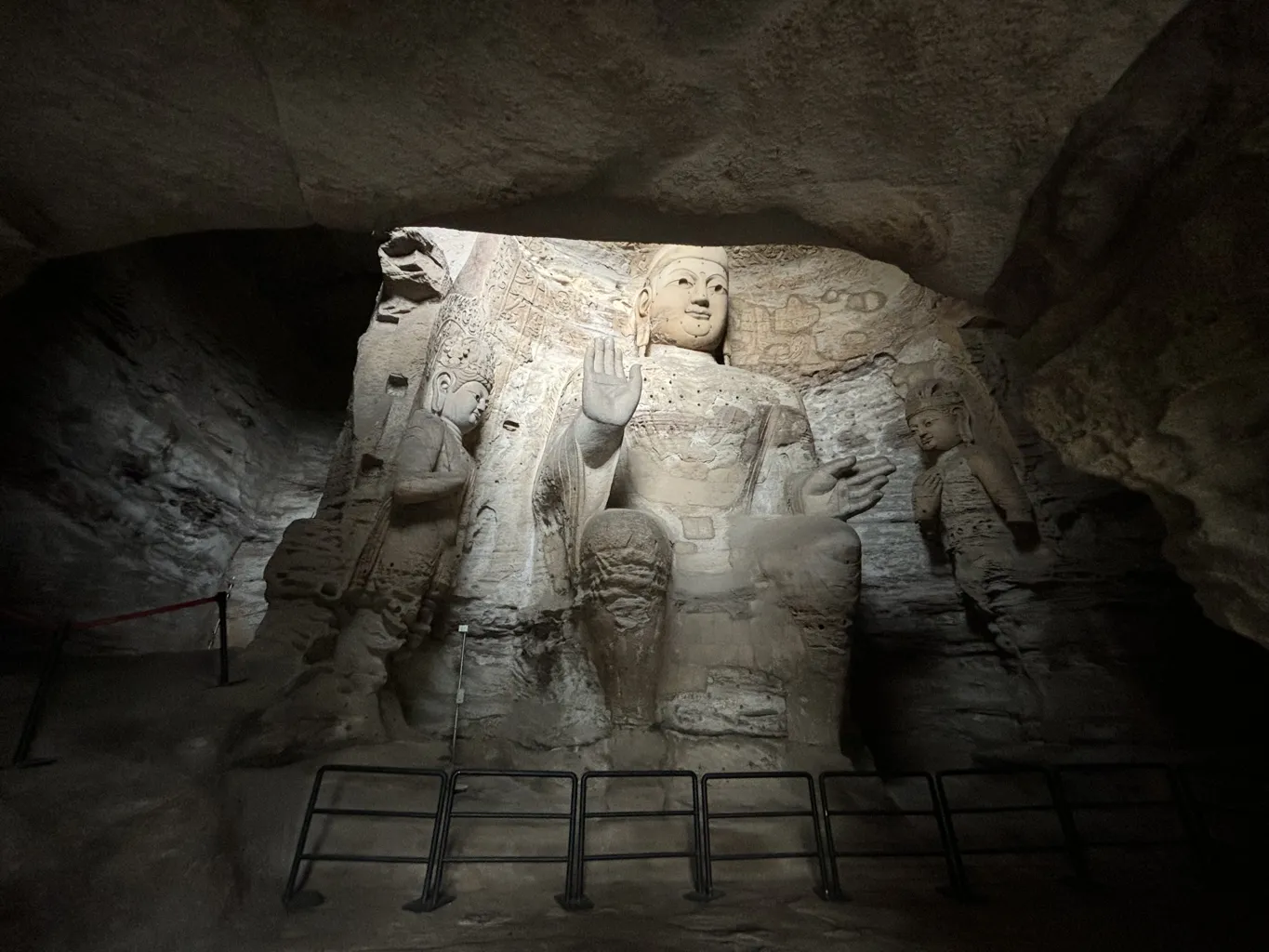
Architectural Features and Iconography
The cave’s design includes a terrace flanked by three-step square towers on each side. Nestled between these towers are two windows, and situated between the windows is a cave. The main figure within this cave is a Maitreya Buddha, depicted in a crossed-feet posture. Additionally, the eastern and western sides of the cave each feature a door. These doors lead to carvings of Amitabha, Guanyin, and Mahastamaprapta. These figures represent the holy triad of the west and are prominently displayed on the north wall. The primary image of the Maitreya Buddha stands at an impressive height of 10 meters, with Bodhisattvas on either side.
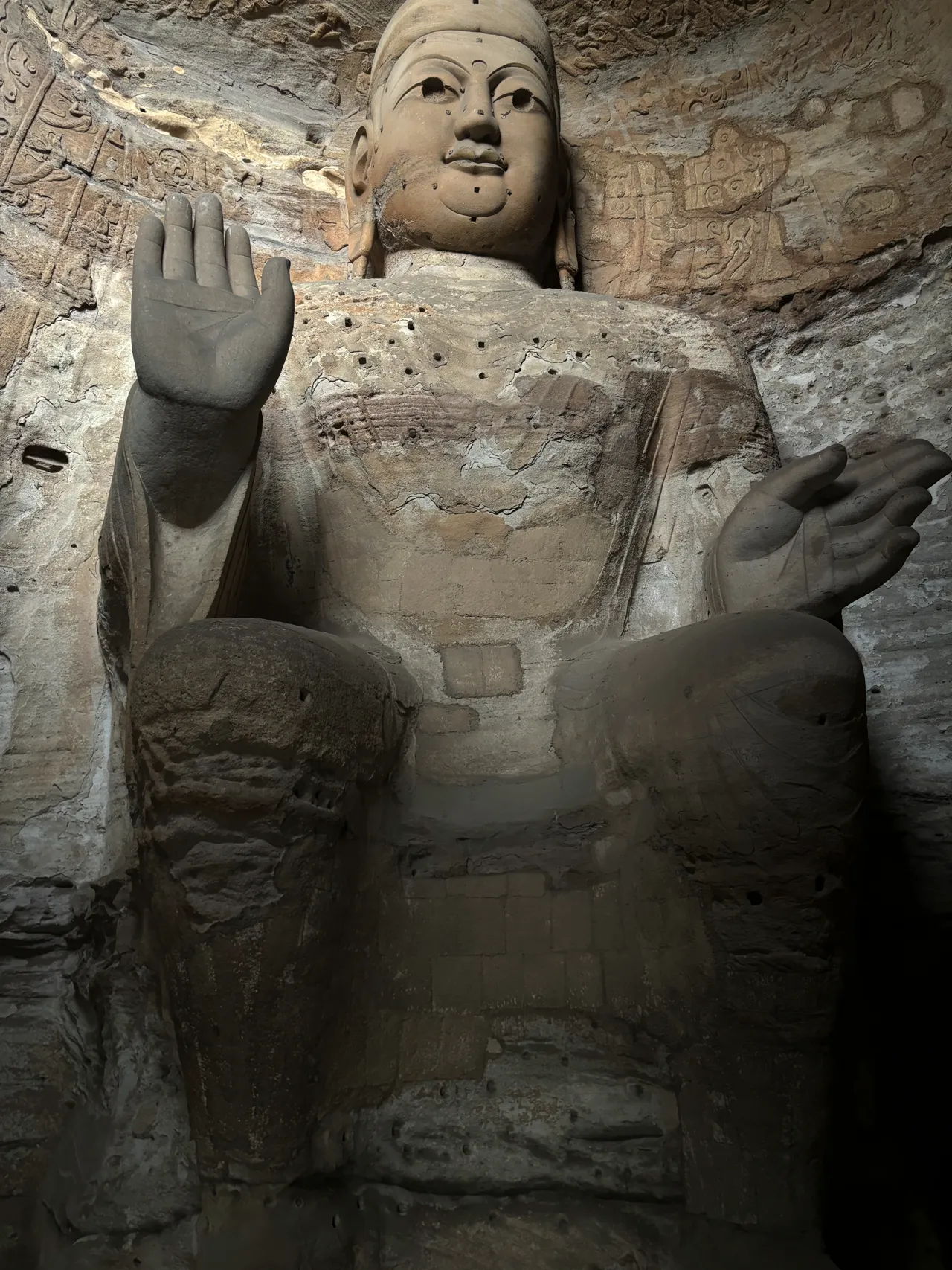
Historical and Cultural Significance
Determining the exact period of the carvings within Ling Yan Cave proves challenging. The Northern Wei, Sui, Tang, and Liang dynasties all emerge as potential contributors, based on the stylistic attributes of the images. Despite these uncertainties, the historical artifacts and remnants within the cave offer valuable insights. They help scholars piece together the rich tapestry of religious and cultural practices during these times.
Overview of Cave No. 4
Cave No. 4 dates back to the period between 494 and 525 AD. It serves as a stupa shrine cave, featuring a single door and two windows. Originally, the plan for this cave remained unfinished.
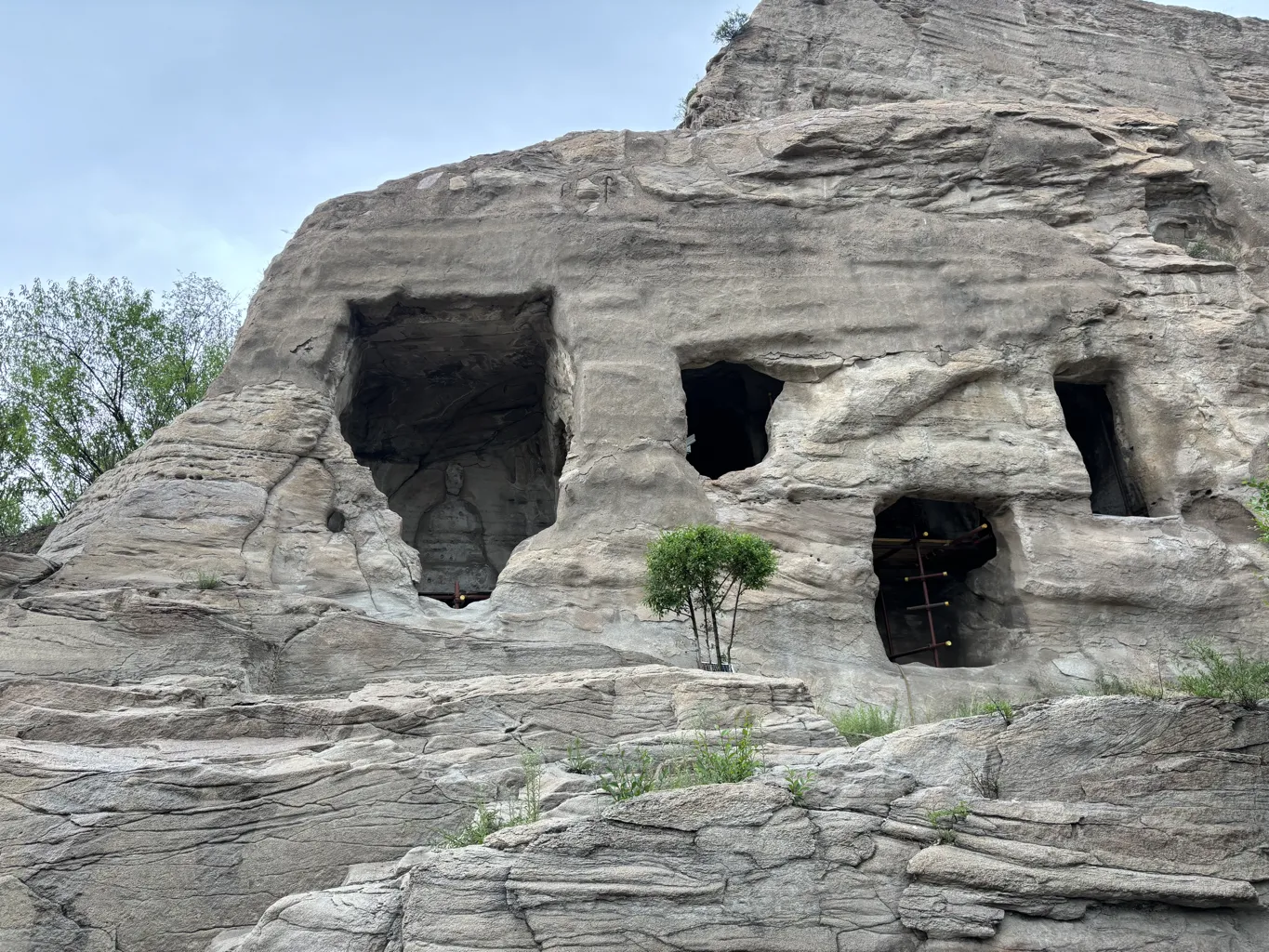
Architectural and Artistic Details
In the heart of the cave, the central column supports one Buddha and two bodhisattvas on each side. Unfortunately, the walls of the cave have suffered extensive damage over time. The southern wall bears an inscription, which is a poignant Record of Iconography for the deceased husband. This inscription stands as the most recent image-making record from the Northern Wei dynasty known to us. However, severe weathering has rendered it nearly unrecognizable.
Cave of the Great Buddha (Cave No. 5)
Constructed between 471 and 494 AD, Cave No. 5, also known as the Cave of the Great Buddha, forms a twin cave system with Cave No. 6. In 1651, Governor-General Tong Yangliang commissioned the construction of four-story wooden structures outside these caves. These buildings, embedded directly into the rock, present a magnificent sight.
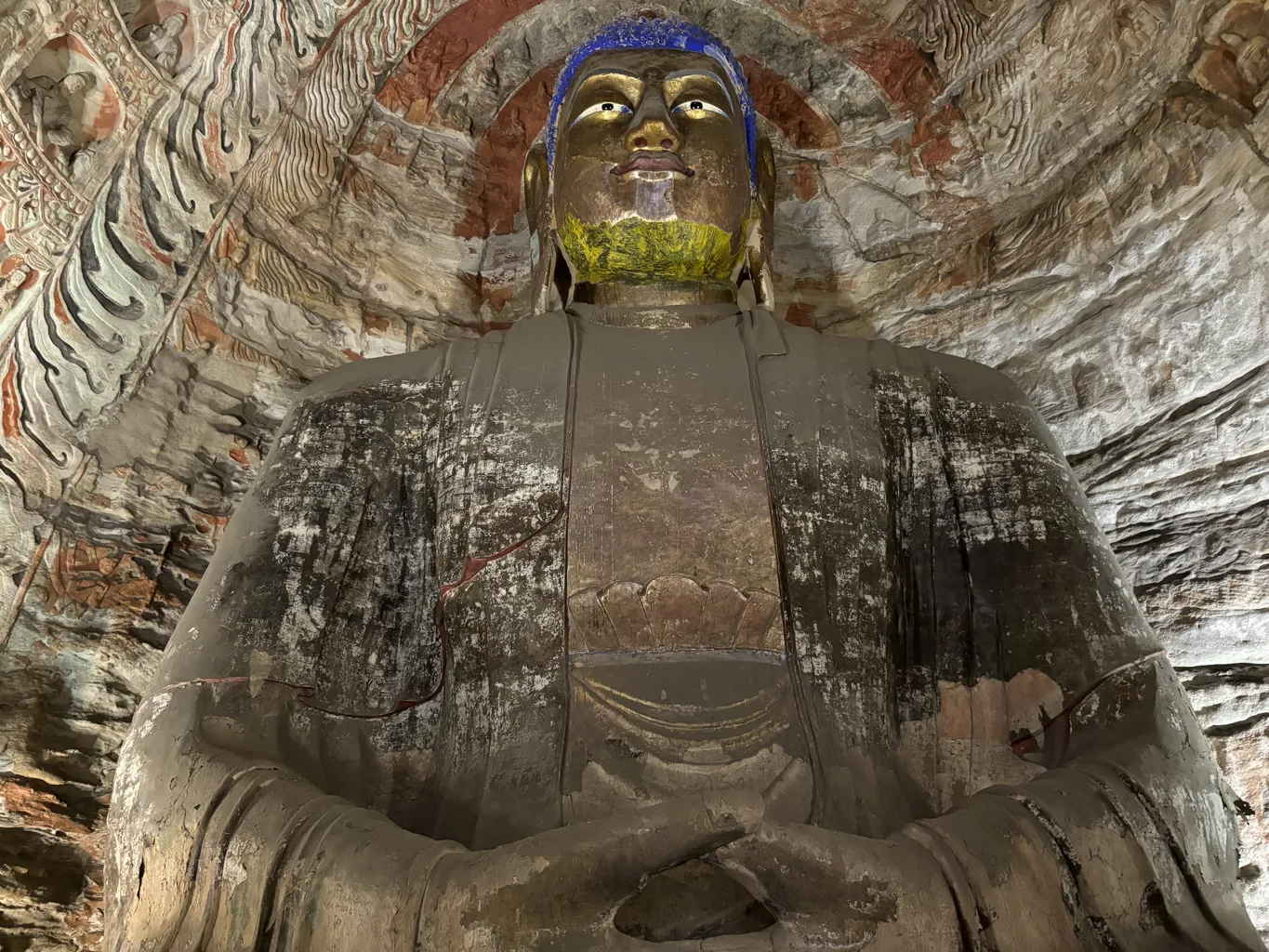
Artistic Features of Cave No. 5
At the entrance of the cave, artisans carved two luxurious holy trees on the upper level of both sides. Beneath these trees sit two Buddha statues, facing each other. They exude an aura of calmness. Additionally, two Lokapalas adorn the lower part of the entrance. They wear coats of mail and bird crests, adding to the majestic ambiance.
The Central Attraction
Dominating the northern wall, a 17-meter-high sitting Buddha statue captures the attention of all who enter. This statue is the largest in the Yungang Grottoes. Craftsmen added another layer of clay and repainted it during the Tang Dynasty, enhancing its grandeur. Flanking this central figure, the eastern and western walls feature additional Buddha statues. The one on the west stands out with its curved eyebrows, straight nose, and a joyful smile.
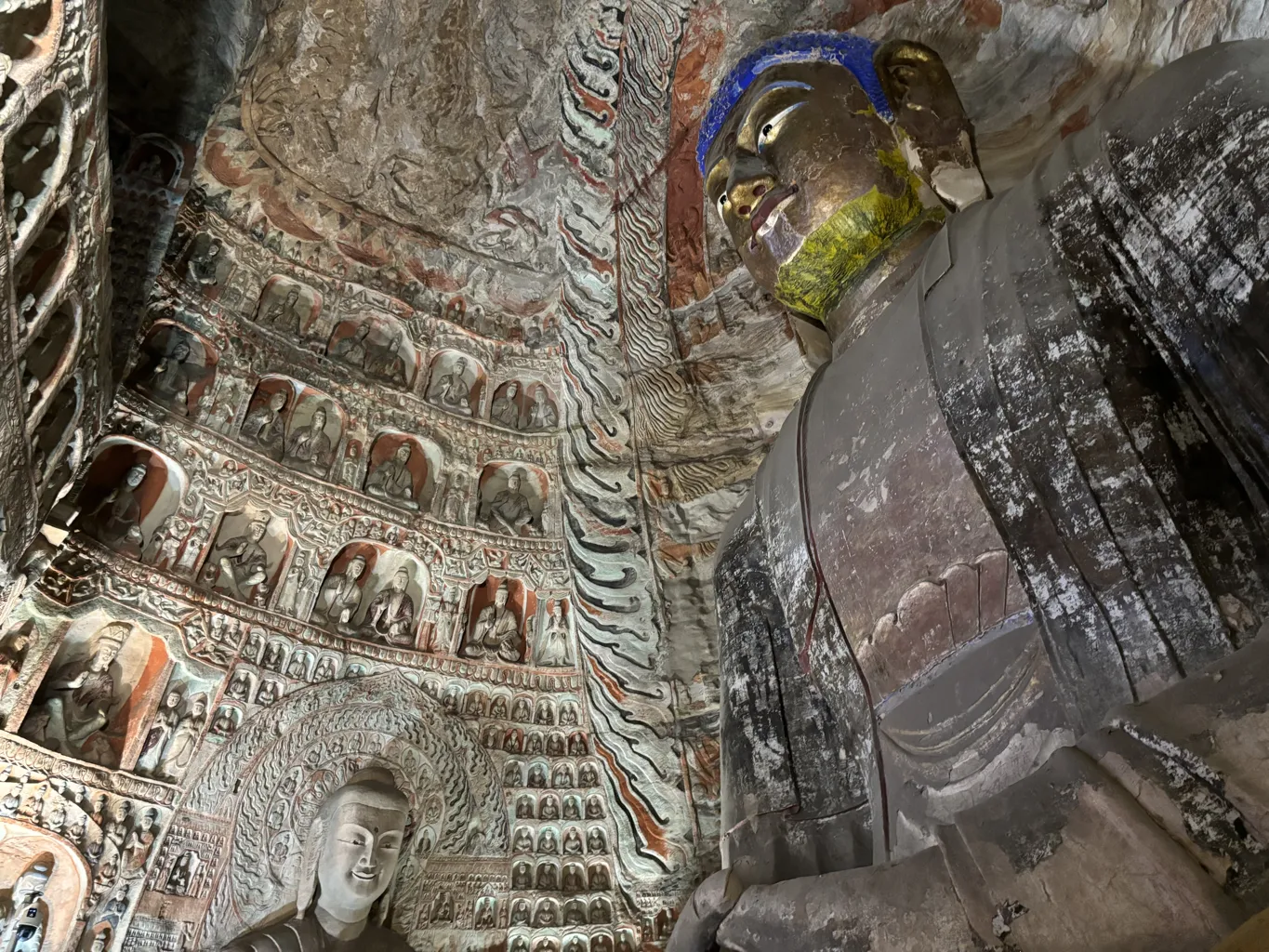
Worship and Reflection
A corridor under the rear wall provides a space for worship and reflection, allowing visitors to engage deeply with the serene environment and the artistic expressions within Cave No. 5. This setup not only preserves the spiritual ambiance but also enhances the visitor’s experience of the cave’s historical and cultural significance.
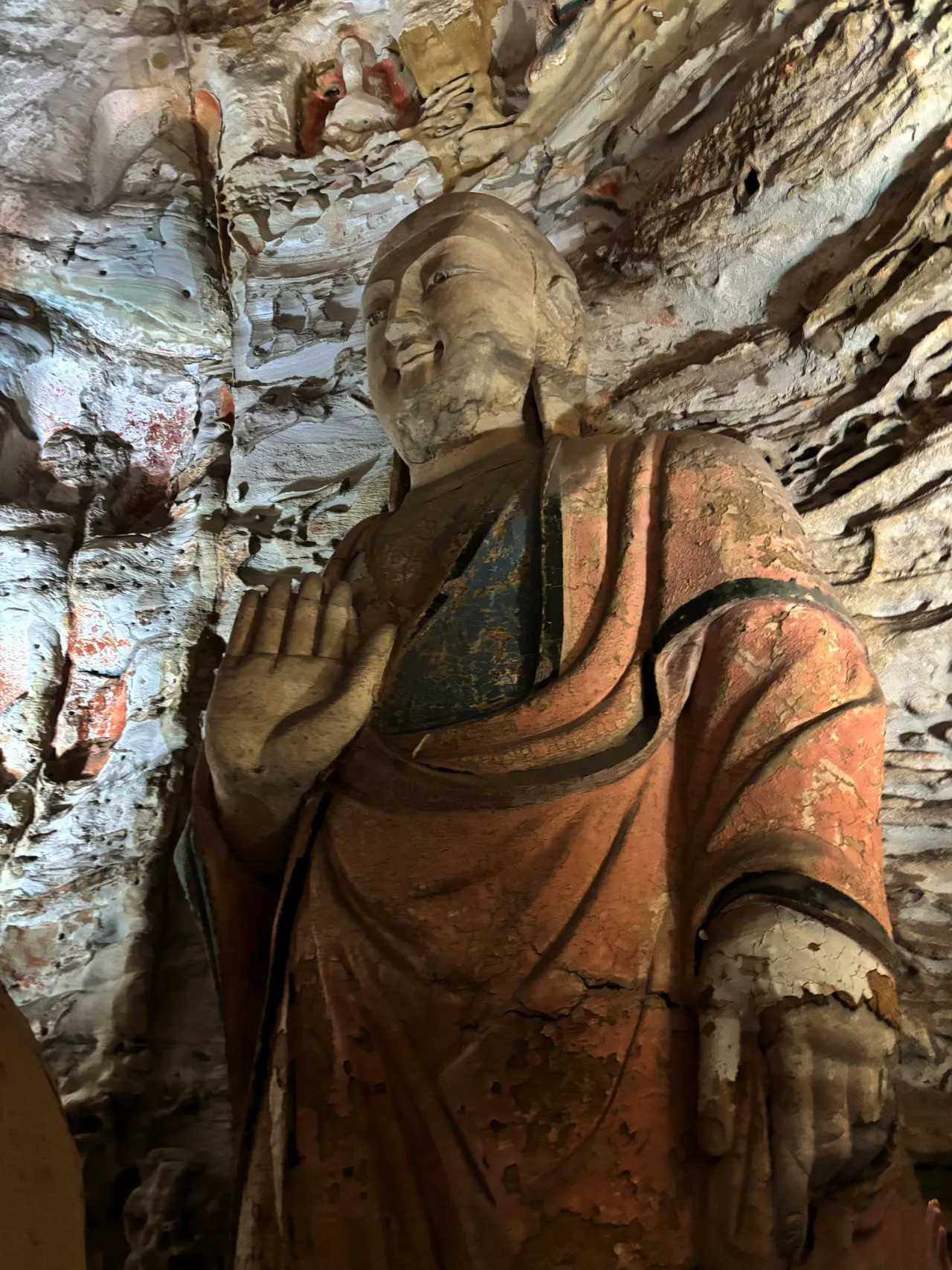
Cave of Sakyamuni (Cave No. 6)
Constructed between 471 and 494 AD, Cave No. 6, also known as the Cave of Sakyamuni, features a central column design, commonly referred to as a “stupa temple cave.” Renowned for its rich decorations, this cave stands out as the most spectacular in the Yungang Grottoes.
Architectural and Artistic Details
The central square column, rising 15 meters high, divides into two levels. On each side of the upper level, a standing Buddha flanked by two Bodhisattvas commands attention. Impressively, an elephant at each of the four corners supports a nine-story square pagoda on its back, depicted in exquisite hollow relief.
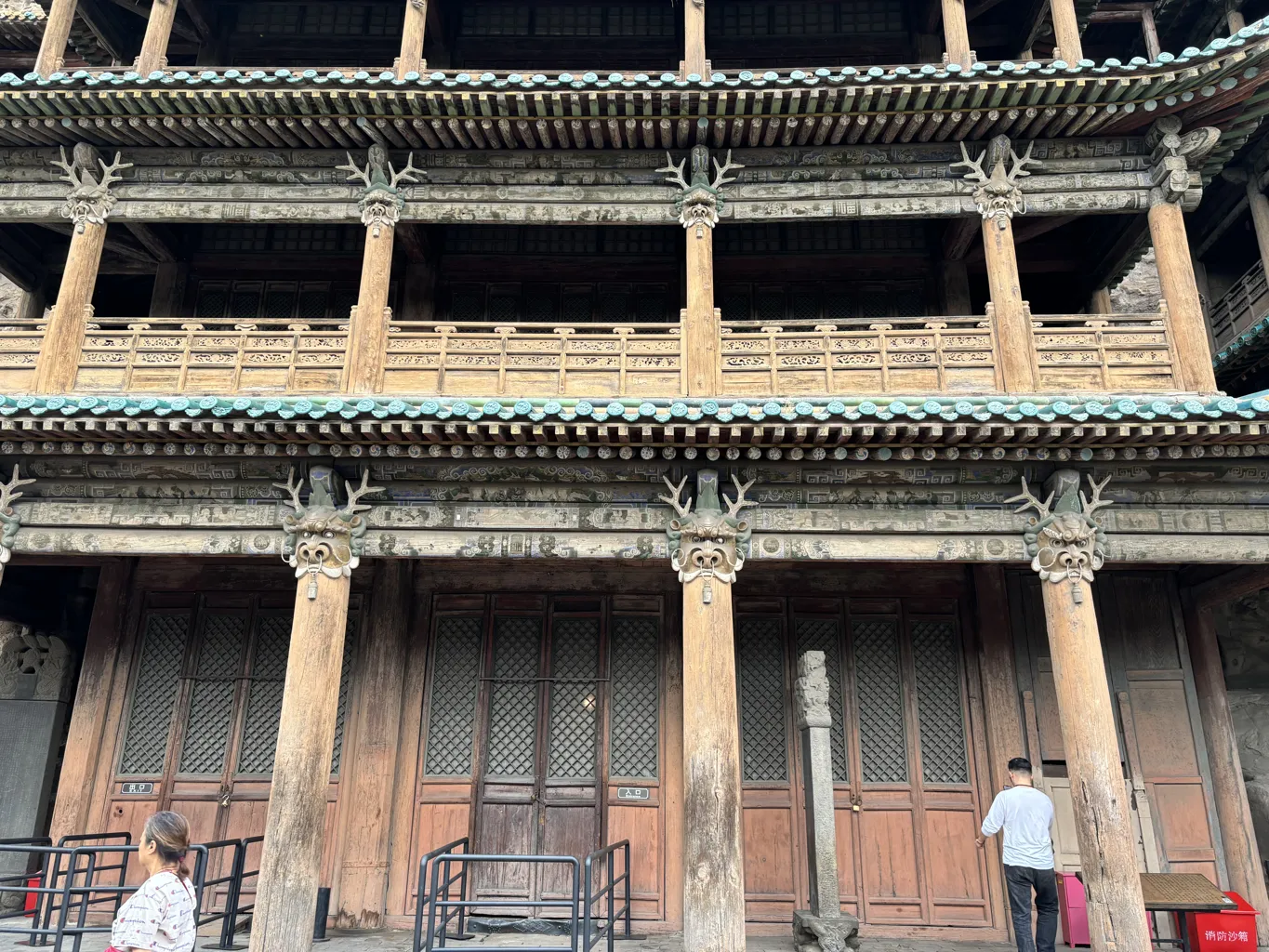
Lower Level and Wall Decorations
Each side of the lower level features a niche housing a sitting Buddha. The upper portions of the four walls display eleven standing Buddhas, adding to the spiritual ambiance. The cave’s ceiling boasts a checkered pattern, each square hosting celestial beings with multiple heads and arms, riding on animals.
Narrative Carvings
About 30 plots from Buddha’s life adorn the cave, narrating his journey from birth to enlightenment. These carvings, which form a series of magnificent scenes, are not only well-composed but also simple and plain. This artwork represents a novel creation in Eastern Gandhara Buddhist art and holds a rare place in existing Buddhist artistic expressions.
The Buddha Cave (Cave No. 7)
Constructed between 471 and 494 AD, Cave No. 7, also known as The Buddha Cave, is one of the earliest twin caves at Yungang, paired with Cave No. 8. This cave features distinct architectural and artistic elements that highlight a significant cultural exchange during this period.

Architectural Layout and Cultural Fusion
Cave 7 consists of front and back chambers, with the main chamber being horizontally rectangular. The sculptures within exhibit a blend of Han Chinese and Western styles, showcasing the cultural interactions between the East and the West.
Artistic Elements and Sculptures
On either side of the window, sculptures of pensive Bhiksus meditating under Bodhi trees capture the viewer’s attention. The large niche on the northern wall’s top level houses the cross-ankled Maitreya, flanked by sitting Buddhas. Below, statues of Sakyamuni and Prabhutaratna Buddha sit side by side, symbolizing unity and harmony.
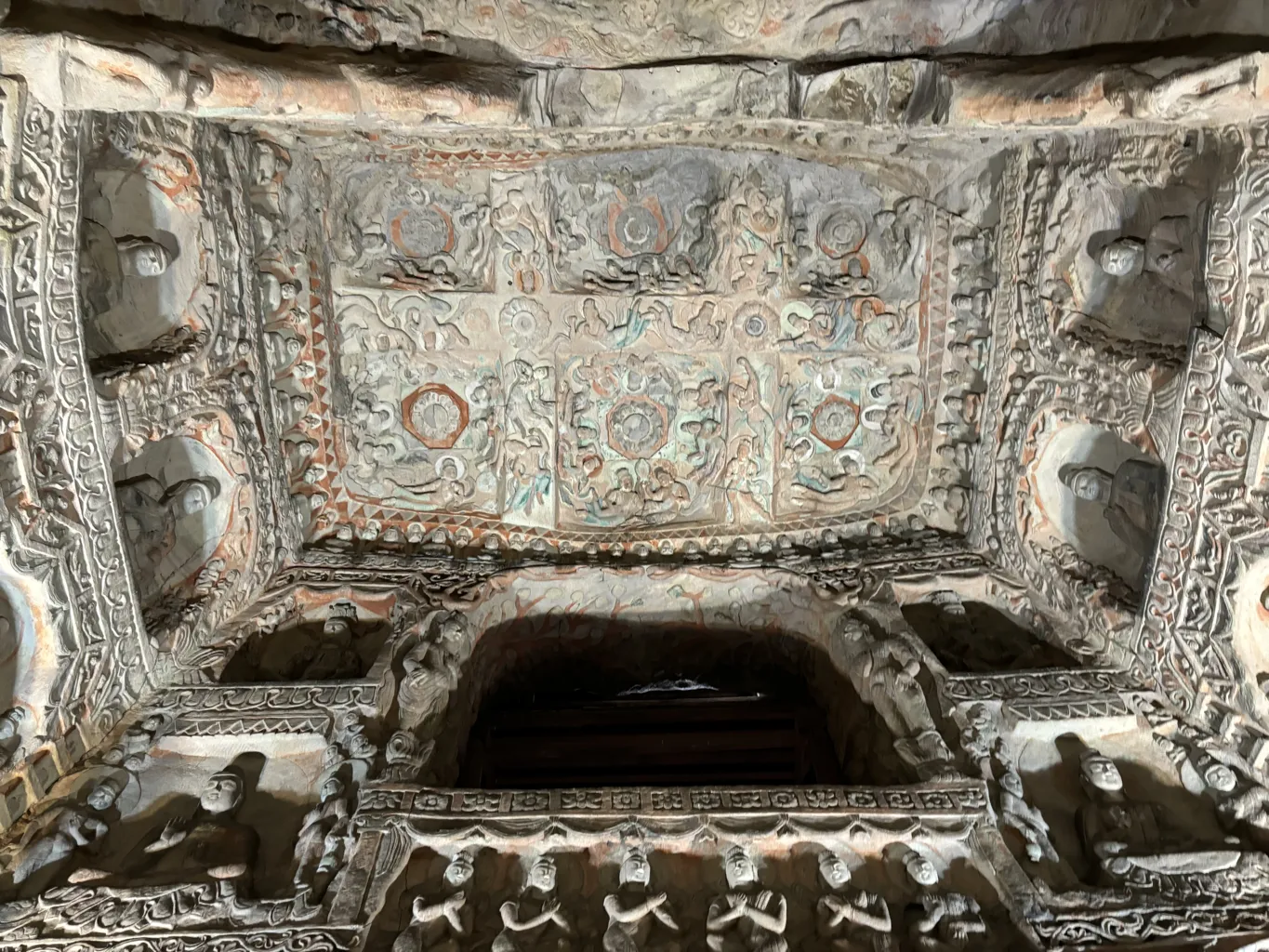
The “Six Beauties at Yungang”
On the south wall, a niche contains six offering celestials, known as the “Six Beauties at Yungang.” These figures, with high buns and kneeling on one leg, blend charm and elegance. They represent an excellent integration of Western sculptural techniques with Oriental artistic elements.
Ceiling Design and Decorative Motifs
The ceiling features chessboard designs that meticulously imitate wooden structures. Encircling a central lotus flower, twenty-four pairs of apsaras appear, flying and dancing, adding a dynamic and celestial quality to the cave’s atmosphere. This artistic choice enhances the spiritual and aesthetic experience for all visitors.
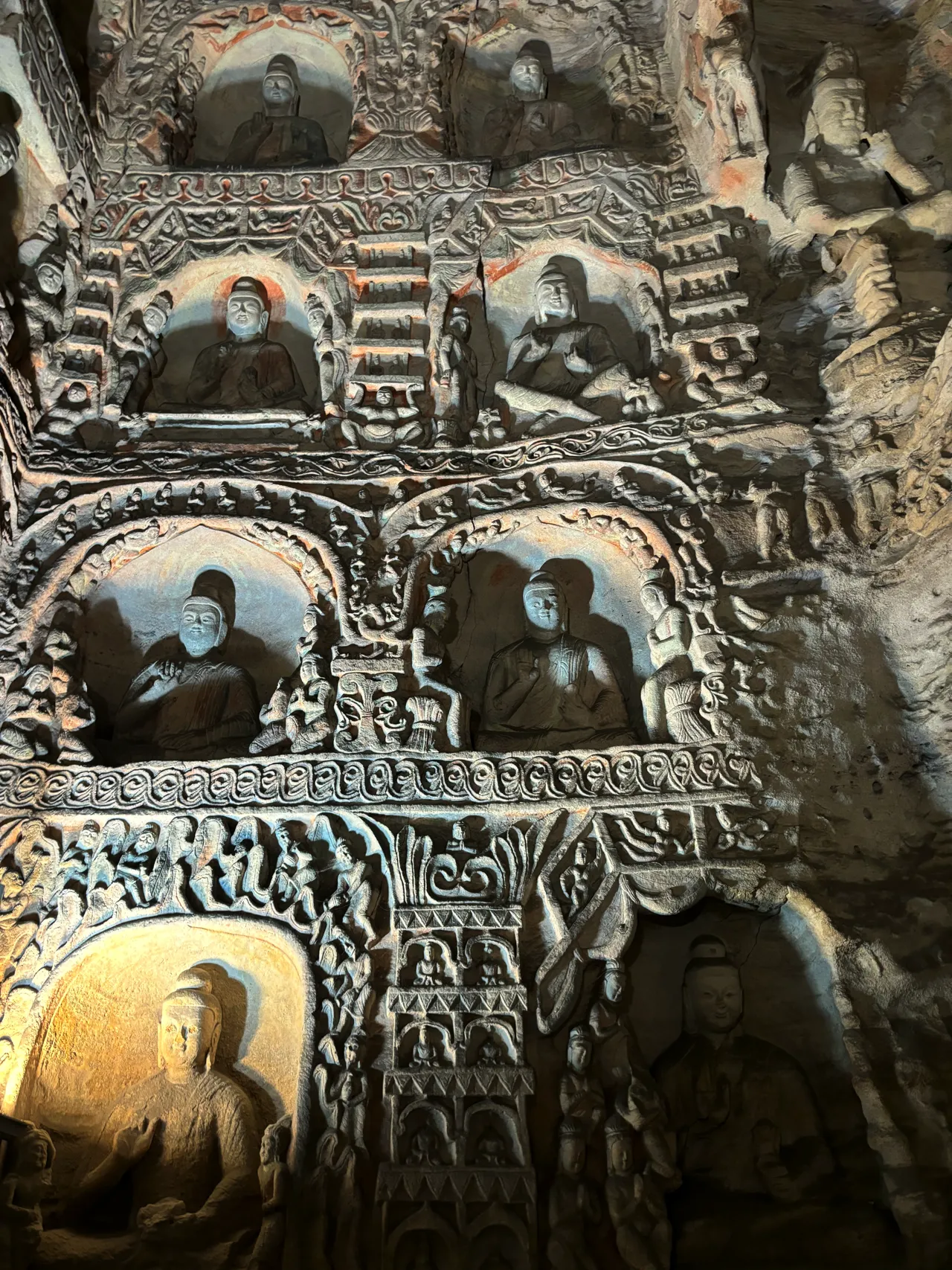
Buddha’s Sound Cave (Cave No. 8)
Constructed between 471 and 494 AD, Cave No. 8, known as Buddha’s Sound Cave, showcases unique sculptures that reflect a strong Western influence. This cave is part of the early twin caves at Yungang, displaying a fusion of early Buddhist art with esoteric elements.
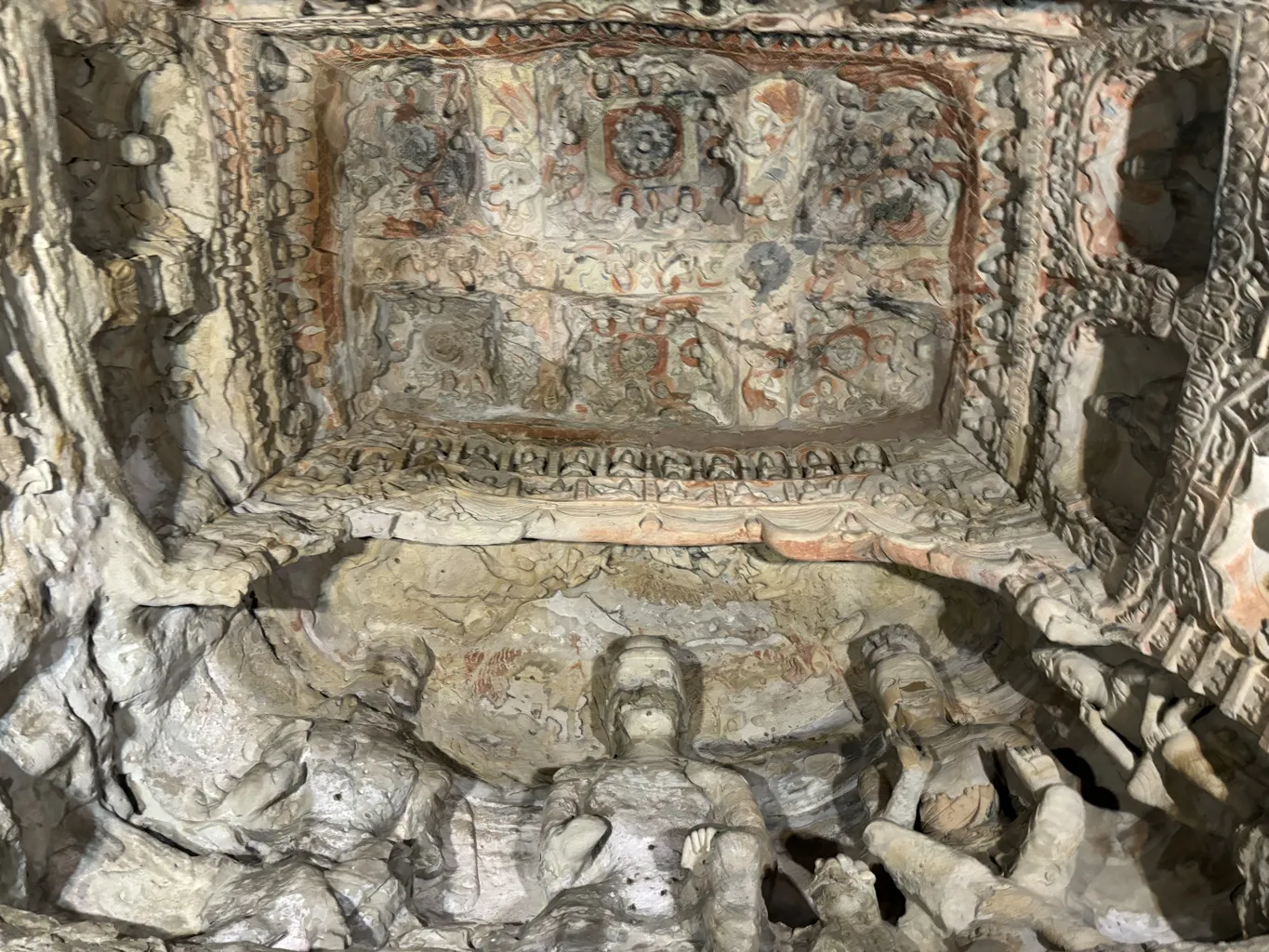
Sculptural Details and Cultural Influences
On the western side of the entrance, a sculpture of Kumara sitting on a peacock immediately draws attention. This figure, with six arms and five heads, embodies a child-like appearance with curling hair. It holds symbolic items such as the sun, moon, a bow and arrow, and a turtledove, indicating significant Western cultural influences.
Mahesvara’s Iconography
Opposite Kumara, on the eastern side of the entrance, stands Mahesvara, depicted riding on a bull. This sculpture features three heads and eight arms, with a full and round face. The smaller heads on either side of the main face wear peaked caps, adding to the intricate detail of the sculpture. Mahesvara’s hands are diversely occupied, one akimbo, another holding heads of grain, and others holding the sun, moon, and a bow and arrow.
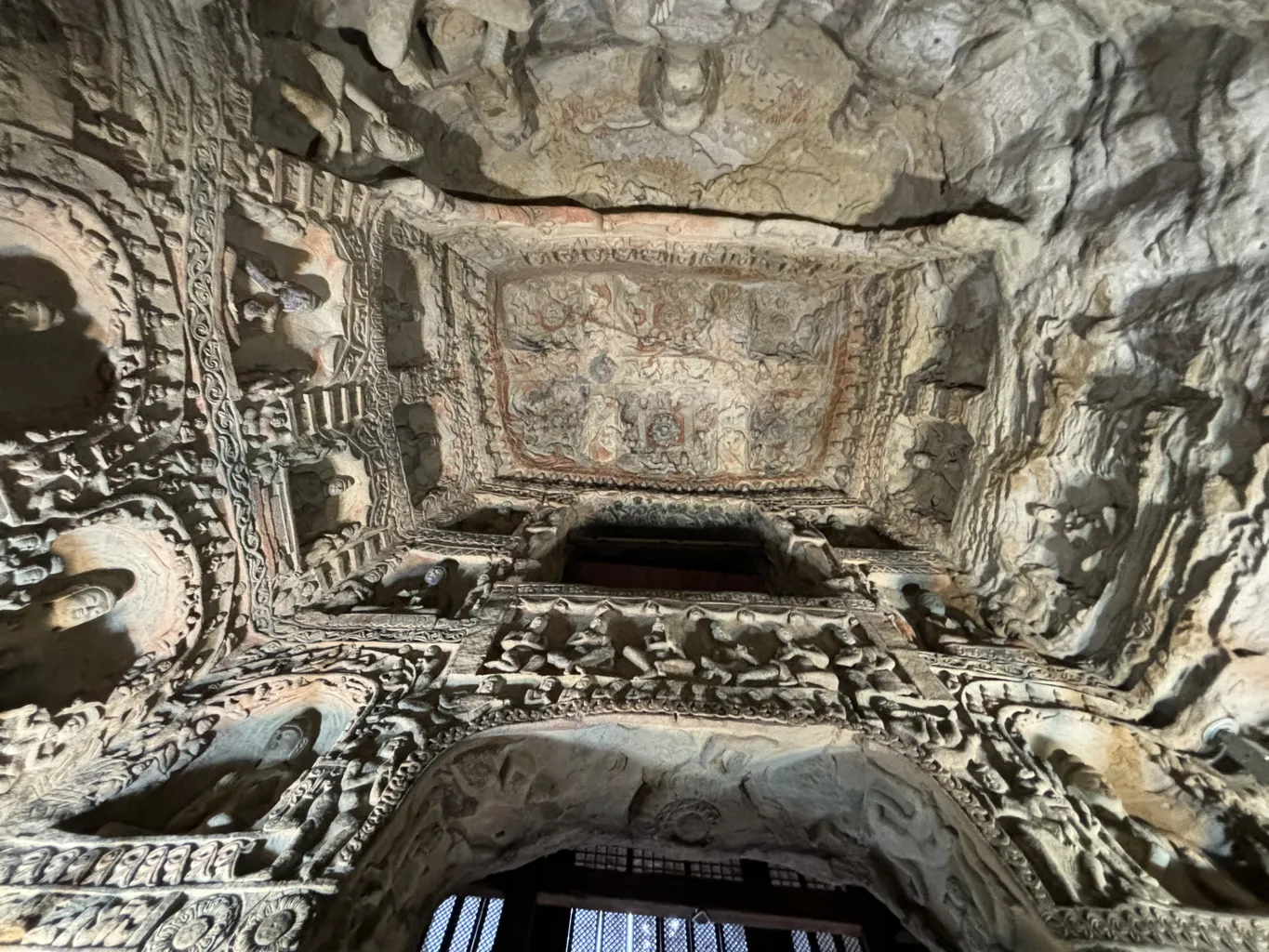
Significance of Multi-Armed and Multi-Headed Figures
Originating from ancient India, these multi-armed and multi-headed figures were initially deities of Brahmanism. Their presence in Cave No. 8 highlights the unique blend of cultural and religious elements that characterize the Yungang Grottoes. This group of sculptures stands out in the Yungang collection, reflecting the characteristics of early Buddhist art merged with esoteric Buddhism, and underscores the dynamic exchange between Eastern and Western artistic traditions.
Aksokhya Buddha Cave (Cave No. 9)
Constructed between 471 and 494 AD during the reign of Xiao Wen, Emperor of the Northern Wei Dynasty, Cave No. 9, part of the “Five Exuberant Caves,” showcases magnificent refurbishments from later periods. This cave, along with Cave No. 10, forms a significant part of the Yungang Grottoes.
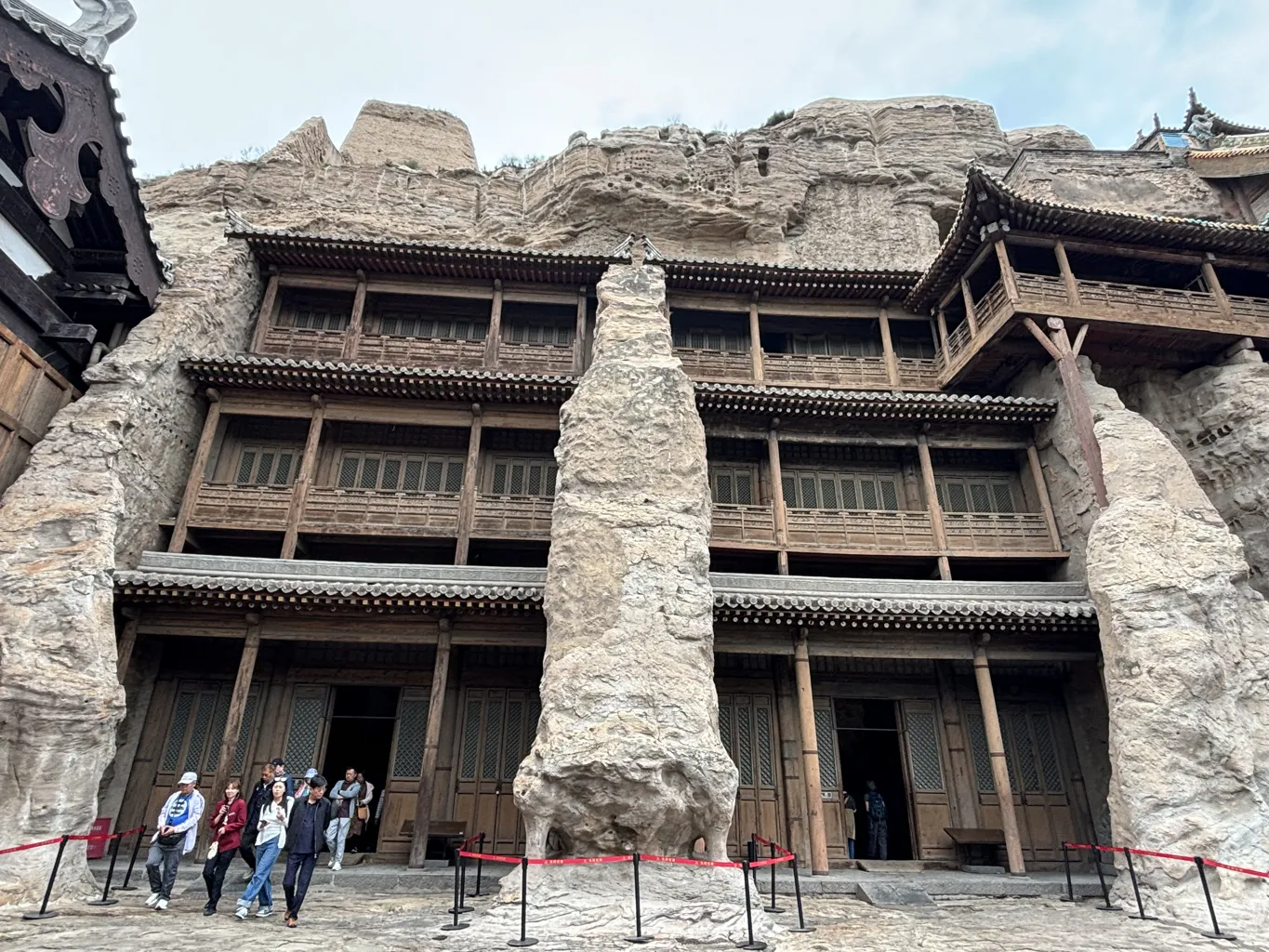
Architectural and Artistic Fusion
Cave 9, paired with Cave 10, features an antechamber and a back room, designed in the style of a Han Chinese assembly hall. The entrance boasts columns intricately carved with images of a thousand Buddhas, lions, and elephants, reflecting traditional Chinese architectural forms. The door is flanked by symmetrically arranged niches, blending Han Chinese and Western architectural elements with a strong decorative appeal.
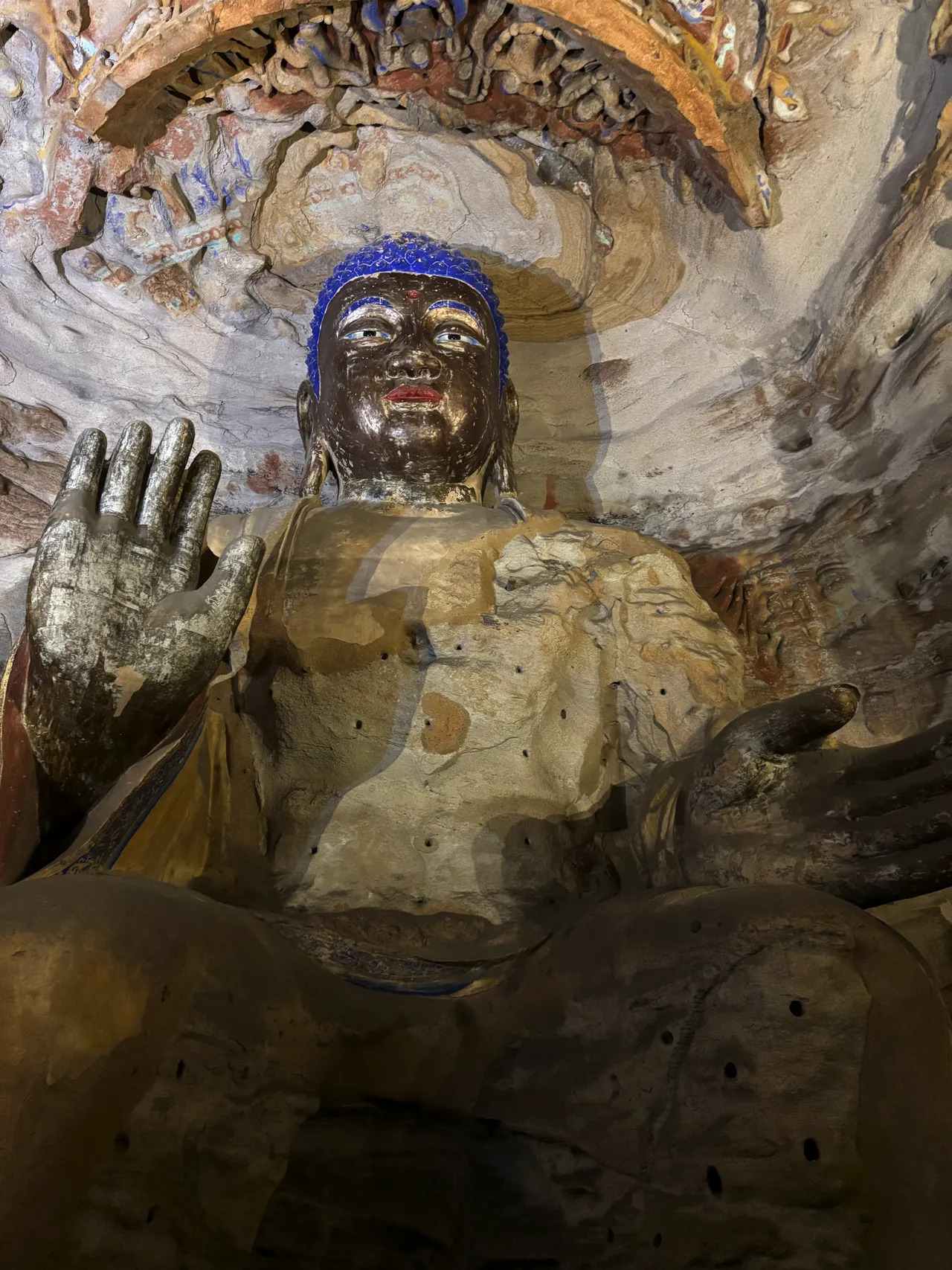
Interior Decorations and Symbolism
The walls of Cave 9 are adorned with layers of niches, each housing statues derived from the Lotus Sutra, emphasizing the sinicization and localization of Buddhist art. The ceiling is decorated with grid designs, featuring lotus motifs and flying Apsaras, adding a celestial touch to the cave’s atmosphere. Additionally, eight robust Yakshas are depicted holding the crossbeam with one hand, symbolizing strength and protection.

Central Sculptures and Their Significance
The main sculpture on the north wall in the back chamber is that of Sakyamuni, the historical Buddha, accompanied by attendant Bodhisattvas carved on the east and west walls. These figures not only enhance the spiritual ambiance but also illustrate the integration of Buddhist themes with local artistic traditions, making Cave No. 9 a remarkable example of cultural and religious artistry in the Yungang Grottoe
Vairocana Buddha Cave (Cave No. 10)
Constructed between 471 and 494 AD during the Northern Wei Dynasty, Cave No. 10, also known as the Vairocana Buddha Cave, is part of the renowned “Five Exuberant Caves.” This cave, along with Cave No. 9, showcases intricate carvings and architectural designs that reflect the imperial grandeur of the period.
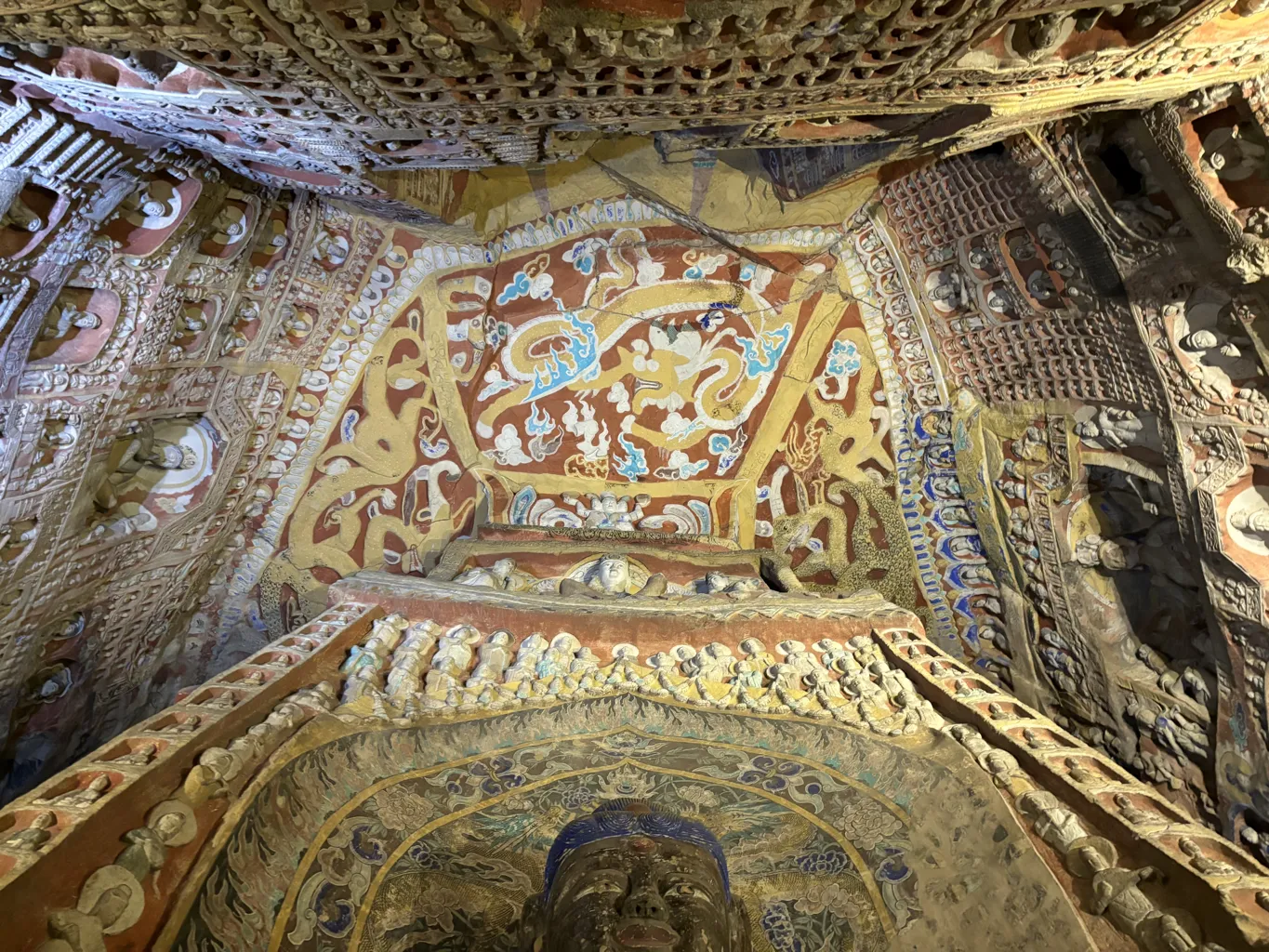
Artistic and Architectural Elements
The front room’s north wall features a depiction of Mount Sumeru, complete with rolling peaks and two coiled dragons midway up the mountain. Dense forests and running animals enhance the dynamic scenery. Flanking the mountain are images of Asura in Lalitasana posture, multi-armed and multi-headed, holding the sun and moon, symbolizing cosmic balance.
Interior Decorations and Symbolism
On the east and west walls, house-like niches in a three-hall form contain statues of amiable Buddhas and peaceful, elegant Bodhisattvas. The thinking Bodhisattva, positioned under the Jambu tree, embodies deep contemplation, symbolizing the Four Noble Truths. Warriors by the door, with kind expressions, feathered crowns, and holding diamond pestles, guard the sacred space.
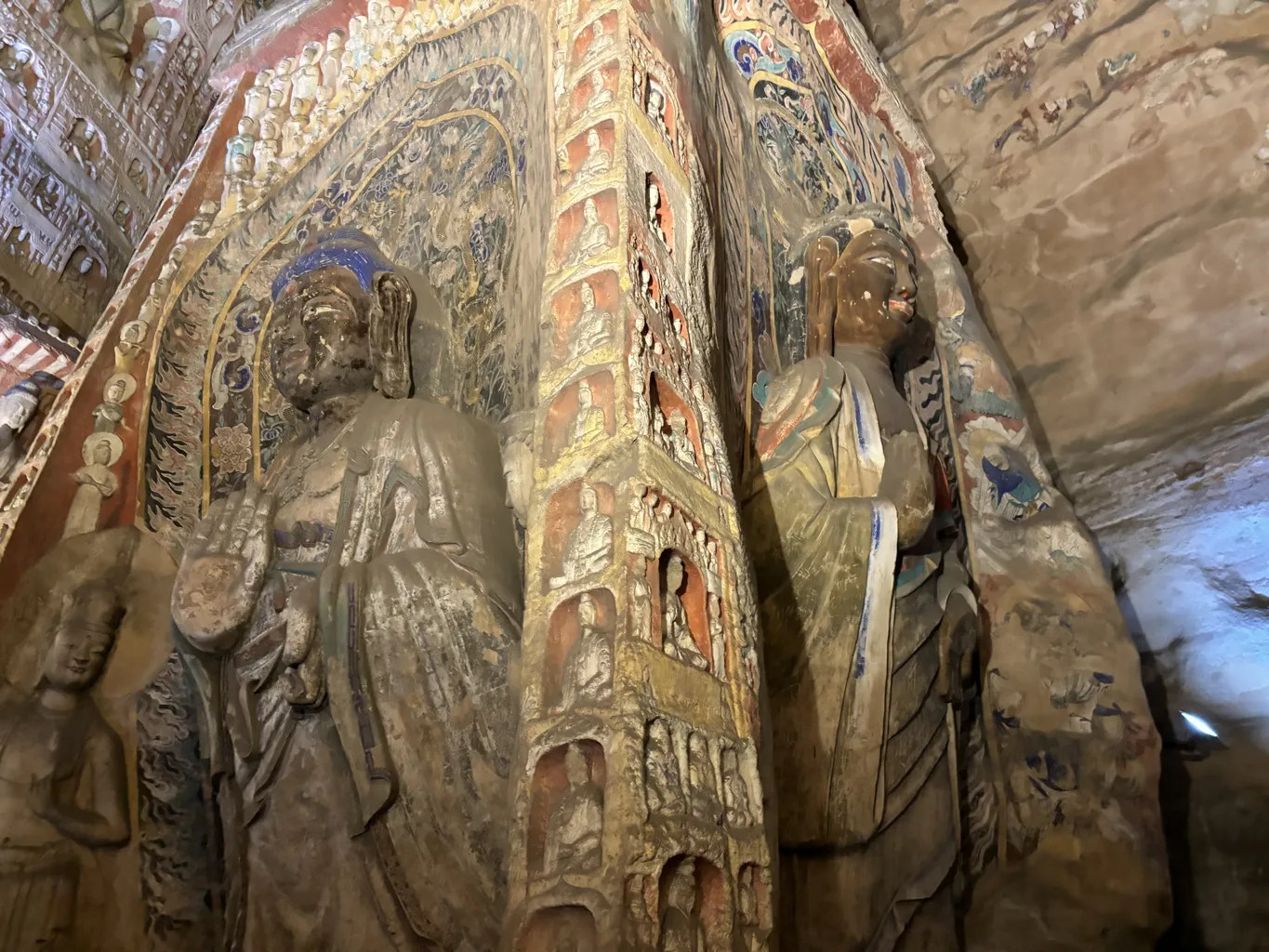
Central Sculptures and Narrative Carvings
The chief sculpture in the back room is Maitreya, flanked by attendant Bodhisattvas carved on the east and west walls. The south wall niches depict Hetuprataya stories, illustrating Sakyamuni’s teachings and his triumphs over heretics, enriching the cave’s spiritual narrative.
Ruins of the Front Yard Floor for Caves 9 and 10
The front yard floor of Caves 9 and 10 features carvings that mimic wooden architecture, indicative of the imperial palaces of the time. Decorations include a band of lotus petals and patterns of four large lotus blossoms, with additional lotus petals and turtle back patterns between columns. These elements not only enhance the aesthetic appeal but also provide crucial clues for exploring the history of the Yungang Grotto Temple. The presence of lotus motifs on the east side and square holes for later wooden pavilions offers significant insights into the architectural evolution at this sacred site.
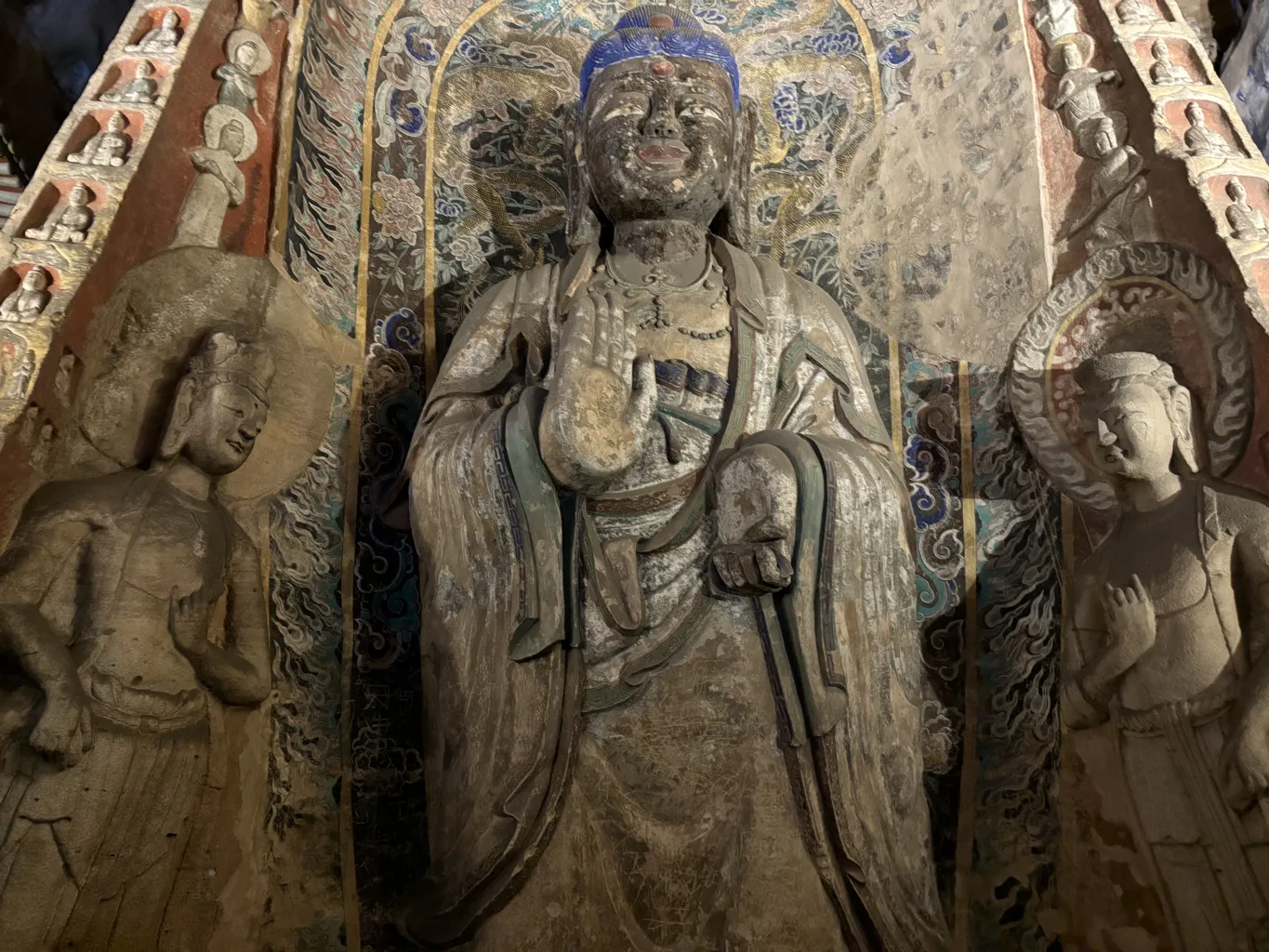
Amitabha Buddha Cave (Cave No. 11)
Constructed between 471 and 494 AD, Cave No. 11, along with Caves 12 and 13, forms a cohesive group within the Yungang Grottoes. This cave is notable for its central pillar, which divides into upper and lower levels, each adorned with significant Buddhist sculptures.
Sculptural and Inscriptional Highlights
The lower level of the central pillar features a standing Buddha on each side, with the southern niche’s Buddha flanked by attendant Bodhisattvas from the Liao Dynasty. The west wall houses a large house-shaped niche containing seven tall standing Buddhas, characterized by wavy hair and plump faces. An inscription from the 7th year of the Tai He period (AD 483) of the Northern Wei Dynasty, found on the upper section of the east wall, holds the distinction of being the earliest and most verbose inscription in the Yungang Grottoes. The calligraphy style of this inscription is celebrated as an exceptional example from Ping Cheng during the Northern Wei Dynasty.
Vimala Bhumi Bodhisattva Cave (Cave No. 12)
Also known as the “Cave of Music,” Cave No. 12, constructed between 471 and 494 AD, features a division into front and back chambers. The outer wall surface of the front chamber mimics wooden roofs, eaves, and columns, enhancing the architectural aesthetics.
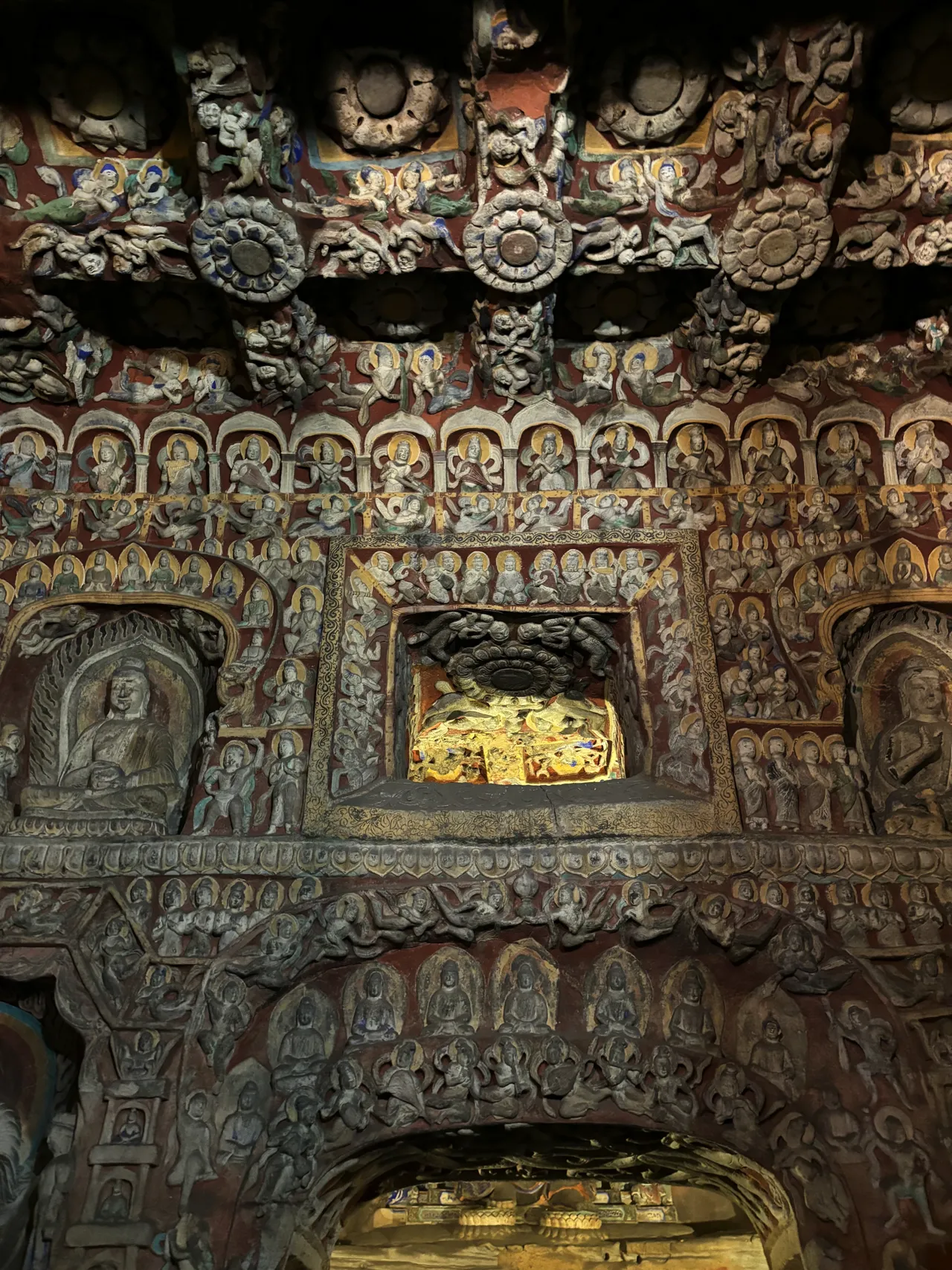
Musical and Cultural Artistry
The north wall’s top portion displays 14 celestial musicians engaged in playing a variety of instruments, including drums, panpipes, lutes, flutes, harps, zithers, and conches. These figures not only showcase the musical diversity but also the physical characteristics typical of northern China’s minorities. The entrance’s lintel features a group of celestial dancers, whose postures mirror those found in the secular world. The detailed depiction of musical instruments and band combinations offers invaluable insights into the court orchestra and social music system of the Northern Wei Dynasty, serving as precious materials for studying the history of ancient Chinese music.
Manjusri Bodhisattva Cave (Cave No. 13)
Constructed between 471 and 494 AD, Cave No. 13 features a domed ceiling and is dedicated to the Manjusri Bodhisattva. This cave is renowned for its grand central sculpture and the distinct influence of Chinese artistic styles.
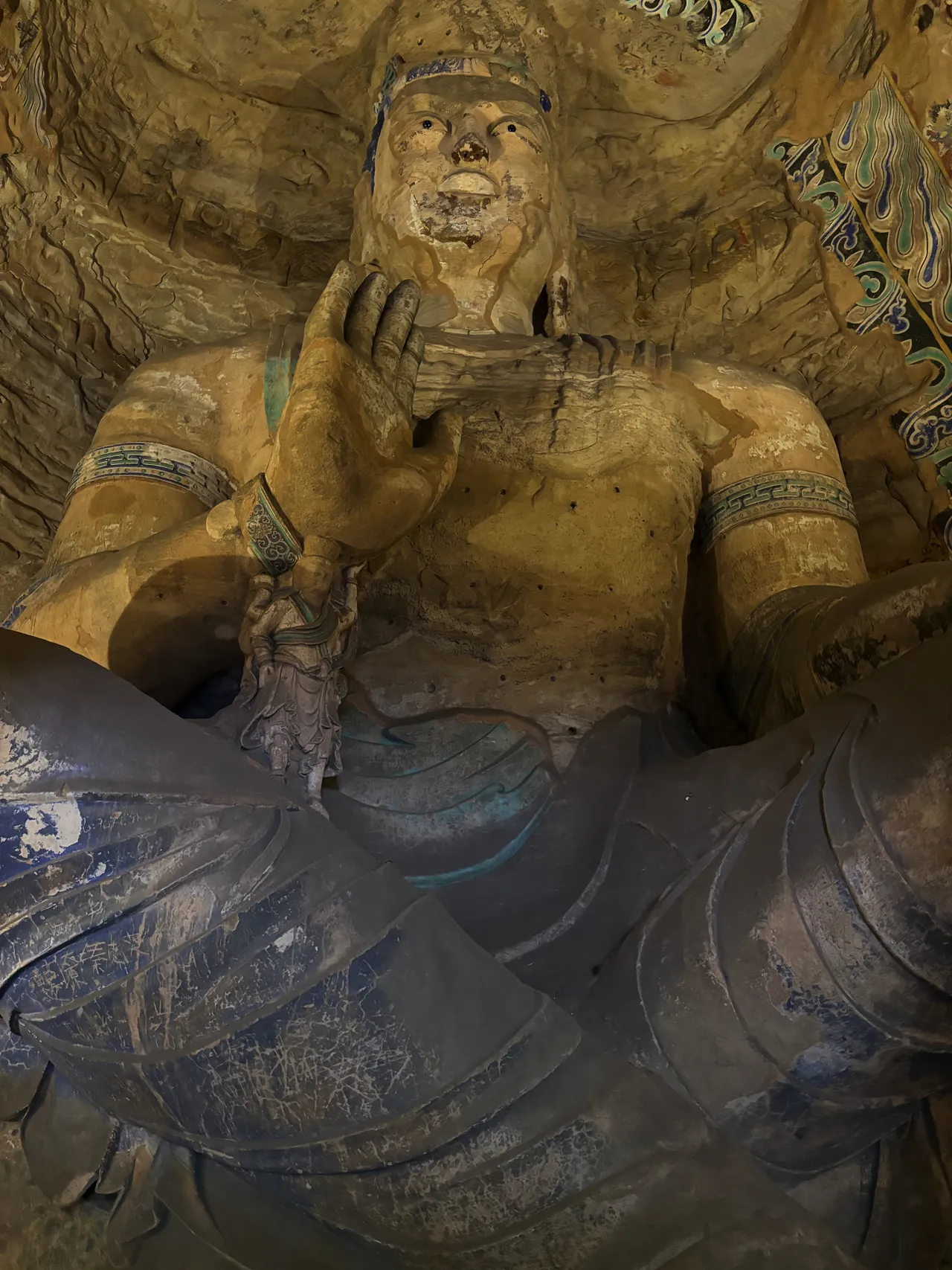
Central Sculpture and Artistic Details
The main attraction of this cave is the 13-meter-high cross-ankled Maitreya Bodhisattva, adorned with a jeweled crown and a necklace with bells and snake-shaped decorations. Notably, the right arm of this statue is supported from underneath by a warrior, a feature restored in later periods, with only the feet on a lotus flower remaining from the original sculpture. The niches, architectural forms, and the tassels and curtains carved on the east wall all reflect a strong Chinese stylistic influence.
The Seven Standing Buddhas
On the south wall, between the window and entrance, a large niche houses seven standing Buddhas. These sculptures are noted for their vivid and elegant forms, enhancing the spiritual and aesthetic atmosphere of the cave.
Cave No. 14: Challenges and Preservation
Constructed between 494 and 525 AD, Cave No. 14 has faced significant challenges, including weathering and water seepage, leading to the collapse of the south wall and part of the ceiling. Despite these adversities, the pillar carved with a thousand Buddhas on the eastern side has survived. The four pillars at the entrance were remade in 1994, based on their original appearance.
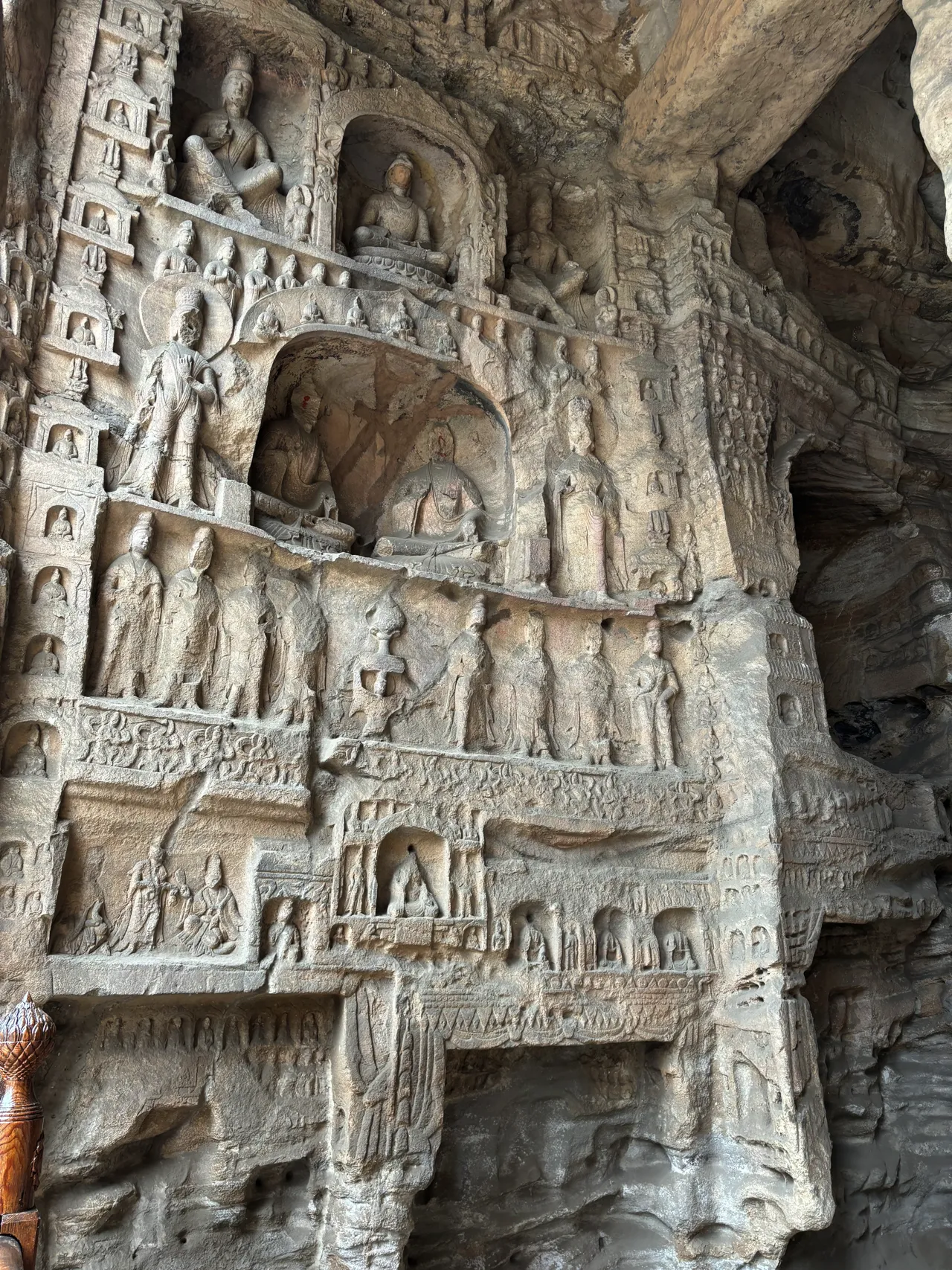
Artistic Representations in Cave No. 14
In the square niche on the lower level of the west wall, sculptures of Vimalakirti on the left and Manjusri on the right depict scenes from the Vimalakirti Sutra. A standing bodhisattva positioned between them holds an alms bowl in the right hand and a lotus in the left, symbolizing the teachings and virtues of Buddhism. These artistic elements not only serve as a testament to the cave’s historical and religious significance but also highlight the ongoing efforts to preserve and restore these ancient treasures.
Overview of Ten Thousand Buddhas Cave (Cave No. 15)
Constructed between 494 and 525 AD, Cave No. 15, originally known as the “Thousand Buddhas Cave,” now houses over ten thousand Buddha images, earning its current name, “Ten Thousand Buddhas Cave.” This square single cave focuses primarily on the depiction of Buddhas, showcasing the ten directions transformed Buddhas, which are manifestations of Sakya. These figures are arranged meticulously, demonstrating precise compositional skills.
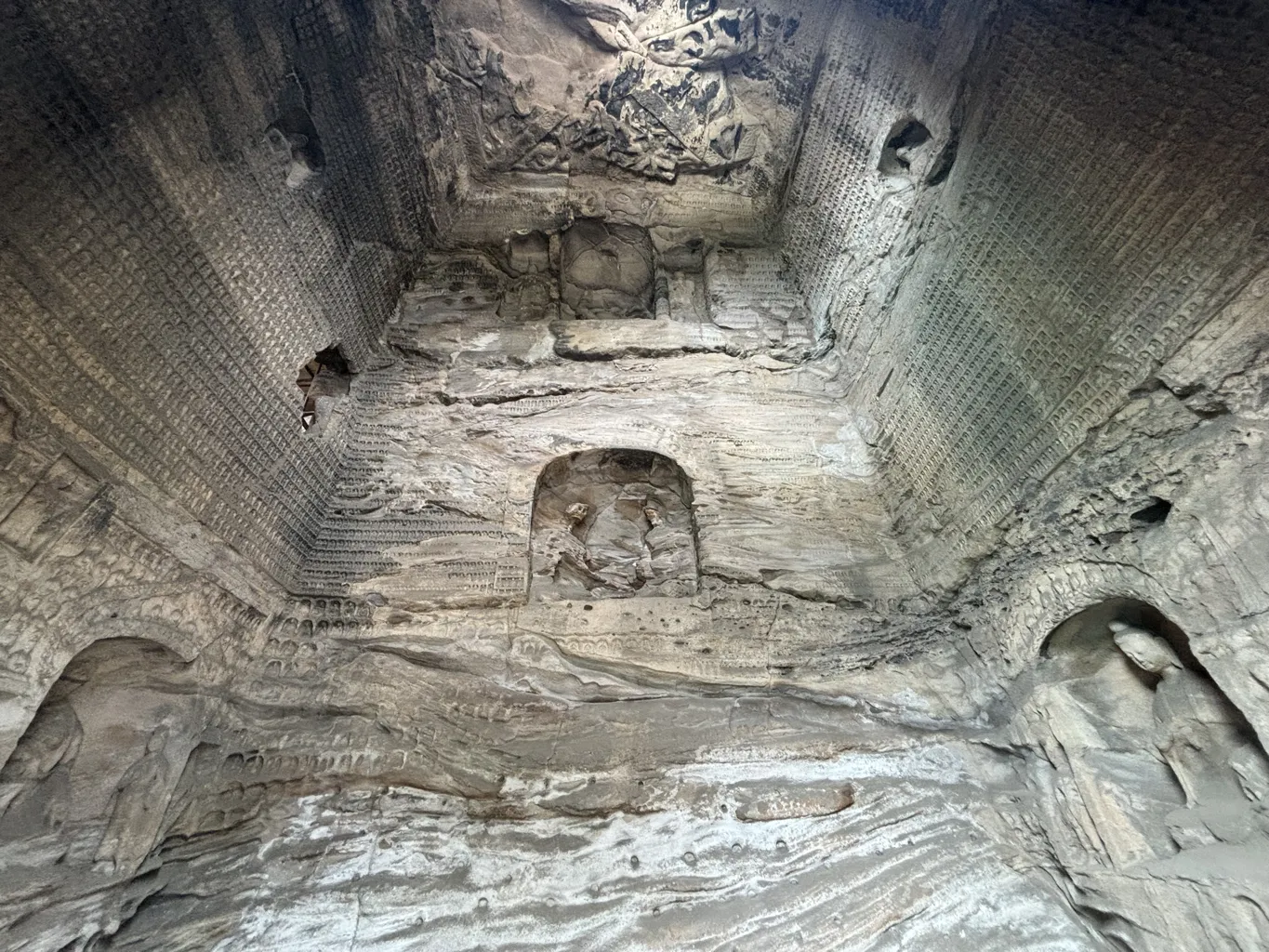
Cave 16
Inside Cave 16, a colossal standing Buddha presents the Abhaya Mudrā, the “mudra of no-fear,” with its hand, symbolizing protection and peace. This gesture adds to the spiritual and aesthetic significance of the statue. The Buddha’s style in Cave 16 distinctively blends Western influences with the characteristics of the Central Plains and Northern peoples, featuring a high head and a beautiful, handsome appearance. This unique fusion has even led Western visitors to describe the Buddha as a “beautiful man,” highlighting its cross-cultural appeal.
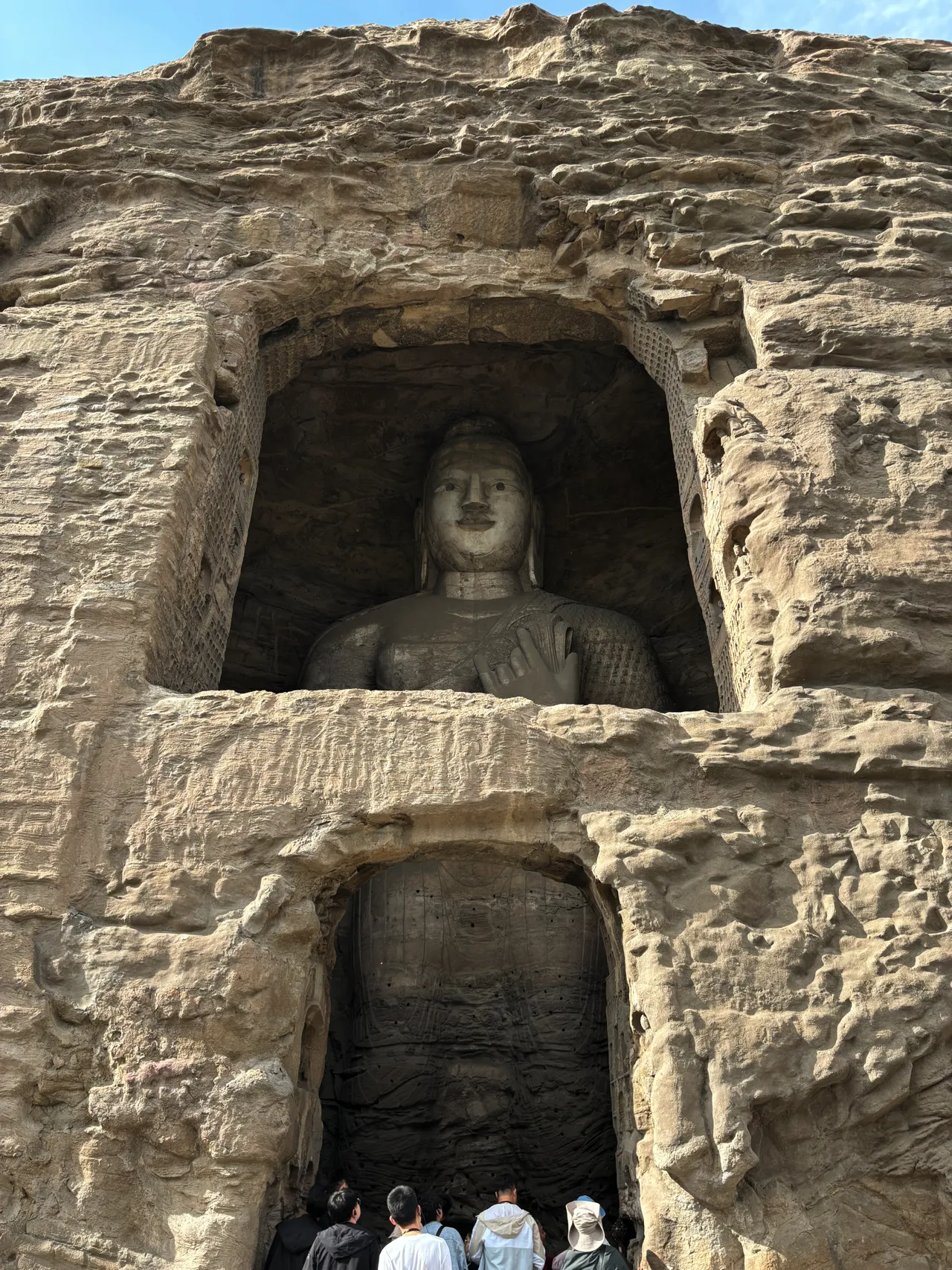
Maitreya Triad Cave (Cave No. 17)
Dating back to between 460 and 470 AD, Cave No. 17 is dedicated to the Maitreya Bodhisattva. The central image, a 15.6-meter-high statue of Maitreya, sits cross-ankled on a lion seat. This statue is adorned with a jewel-studded crown, a snake-shaped necklace, and strings of pearl medallions that hang from the chest, reflecting a strong Western influence.
Artistic Details and Sculptural Elements
The standing Buddha on the west wall of Cave No. 17 features a round face, exuding a solemn and dignified aura. Conversely, the seated Buddha on the east wall displays broad shoulders with smoothly and skillfully engraved garment lines. The walls of the cave are adorned with a thousand Buddhas, representing the artistic characteristics of the early period of the Yungang Grottoes.
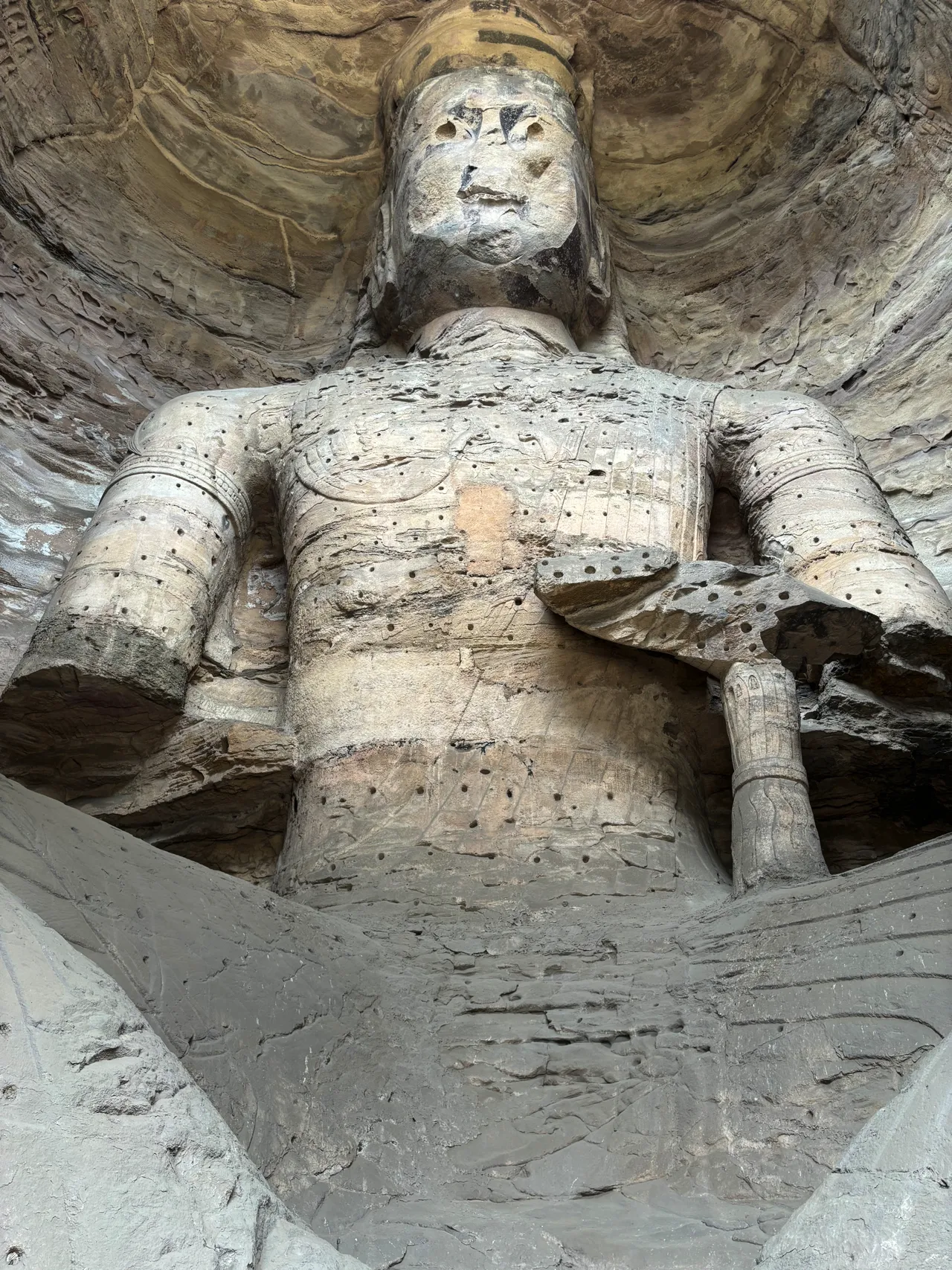
Celestial Offerings and Historical Inscriptions
An offering celestial, carved on the outer rim of the mandorla, presents a demure appearance, vividly sculpted and gracefully shaped, kneeling on one leg and holding a lotus bud. Additionally, an inscription from the 13th year of the Tai He period of the Northern Wei dynasty, located in the niche on the east reveal of the window, serves as a crucial criterion for dating the caves of the Yungang Grottoes. This inscription not only provides historical context but also underscores the cave’s significance in the study of early Chinese Buddhist art.
Cave with Three Standing Buddhas (Cave No. 18)
Constructed between 460 and 470 AD, Cave No. 18 is part of a group that includes Caves 19 and 20, with Cave 19 being the earliest among them. This cave is renowned for its well-designed layout and the central image of a Buddha standing 15.5 meters tall, featuring distinctive attributes such as a protuberance on the head, chubby cheeks, and a high-bridged nose.
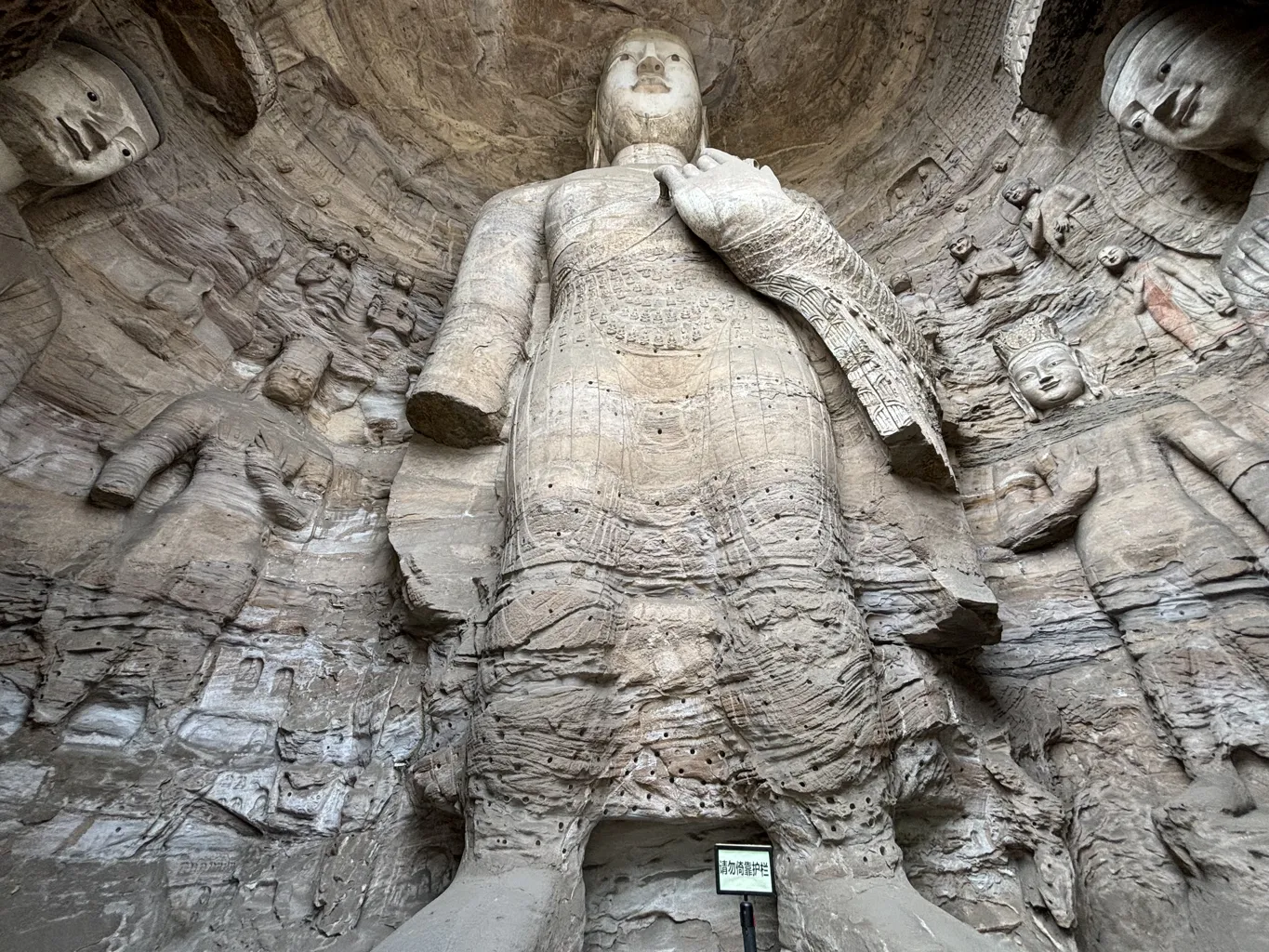
Artistic Details and Sculptural Ensemble
The central Buddha in Cave No. 18 is adorned with a cassock embellished with a design of a thousand Buddhas. Flanking this central figure are sculptures of other Buddhas, attendant Bodhisattvas, and ten eminent disciples. The Buddha on the left is distinguished by a canopy overhead, a round face, and a strong torso. The attendant Bodhisattva on the left side is depicted wearing a floral crown, exuding a gentle and graceful demeanor. The disciples above display varied expressions and features, some reflecting Western influences, and are depicted in poses such as holding a flask, picking a flower, or listening intently to Buddha’s teachings.
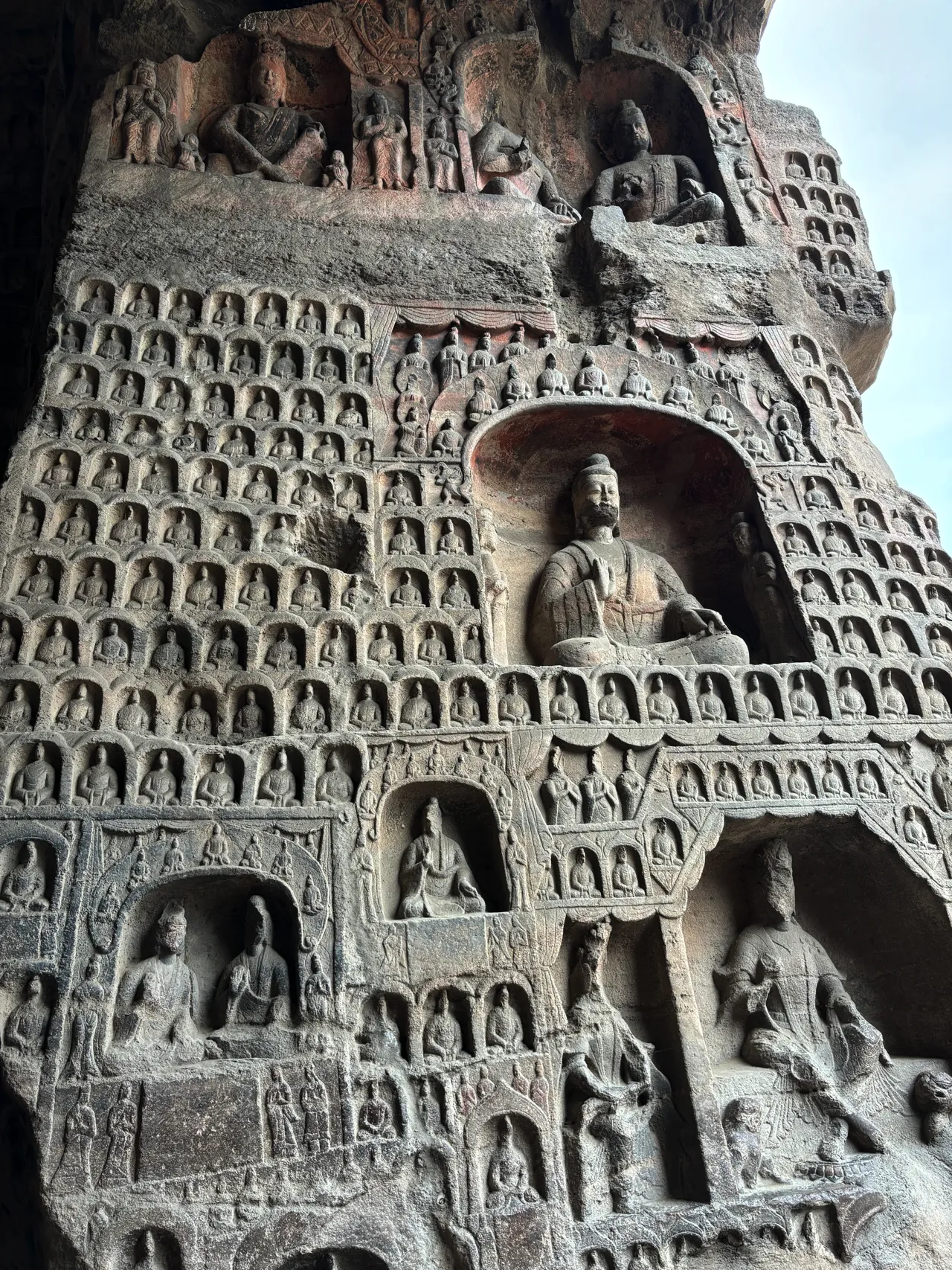
Ratnasambhava Buddha Cave (Cave No. 19)
Also constructed between 460 and 470 AD, Cave No. 19 houses the second-largest Buddha sculpture in the Yungang Grottoes. This Buddha is notable for its long earlobes that reach down to the shoulders. Unfortunately, the cave has suffered structural damage, with the van having collapsed. The Buddha’s right hand is raised, supported by a small pillar, and the monastic robe covering the body features smooth and rhythmical carving lines.
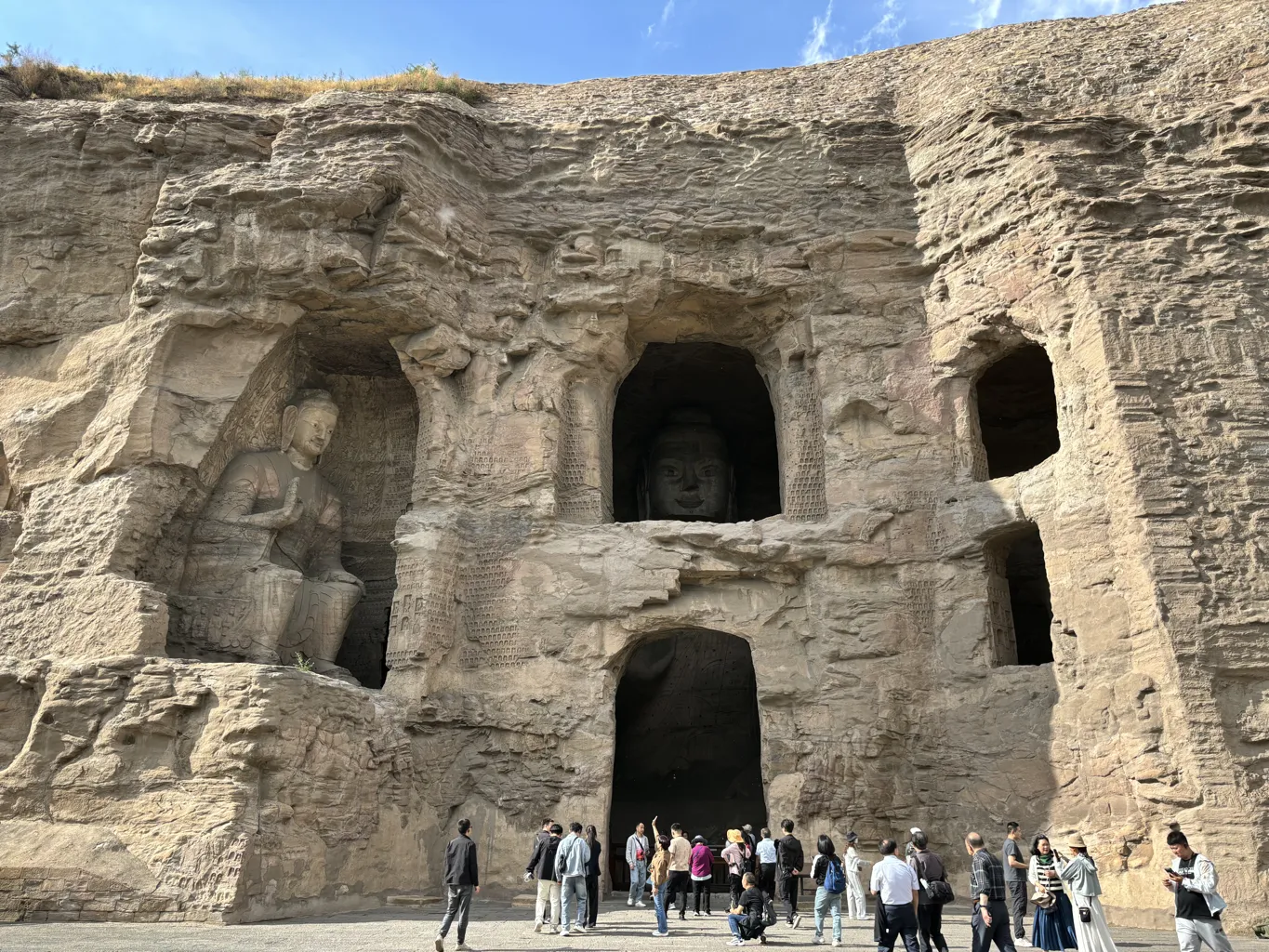
The earliest Buddhist Story and the Trikala Buddhas
The Hetuprataya of Rahula, carved on the south wall, represents the earliest Buddhist story preserved in the Yungang Grottoes. Additionally, on the east and west sides of the main cave, two adjacent chambers each house a seated Buddha, showcasing a unique display of the Trikala Buddhas.
White Buddha Cave (Cave No. 20)
Constructed between 460 and 470 AD, Cave No. 20, also known as the White Buddha Cave, has experienced significant structural challenges over the centuries. The cave’s iron wall and ceiling have collapsed, and a wooden structure from the Liao Dynasty that once stood in front of the cave was destroyed during wartime.
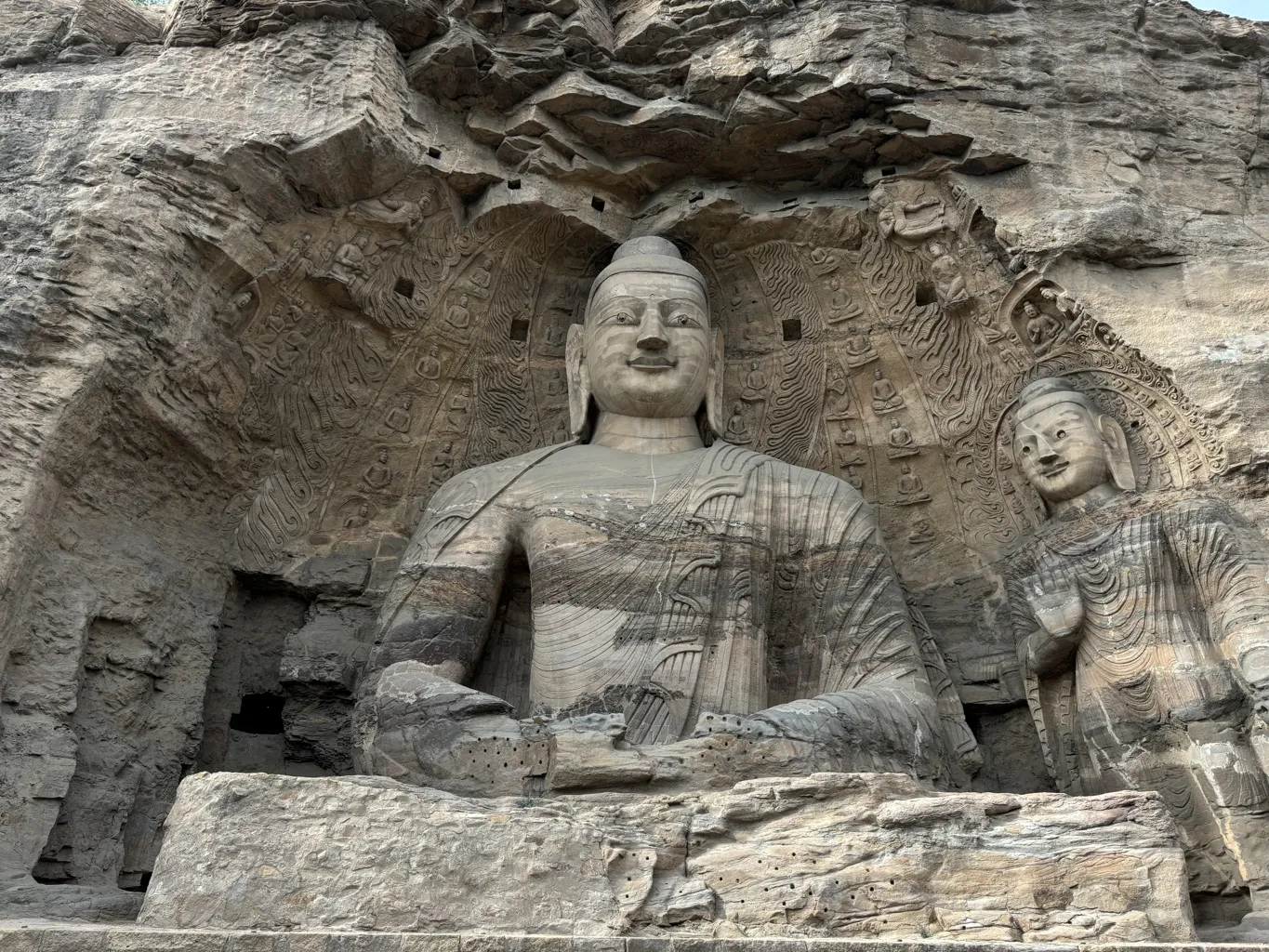
Artistic Features and Cultural Influences
The chief Buddha statue in Cave No. 20 stands at 13.7 meters high and is notable for its high protuberance on the head, broad forehead, full and round face, long eyes, high nose, and a moustache. The Buddha’s hands are positioned in the mudra of meditation. Adorned with a Kasaya that has ridged pleats and leaves the right shoulder bare, the statue reflects the Gandharan influence, indicative of the cultural exchanges along the Silk Road.
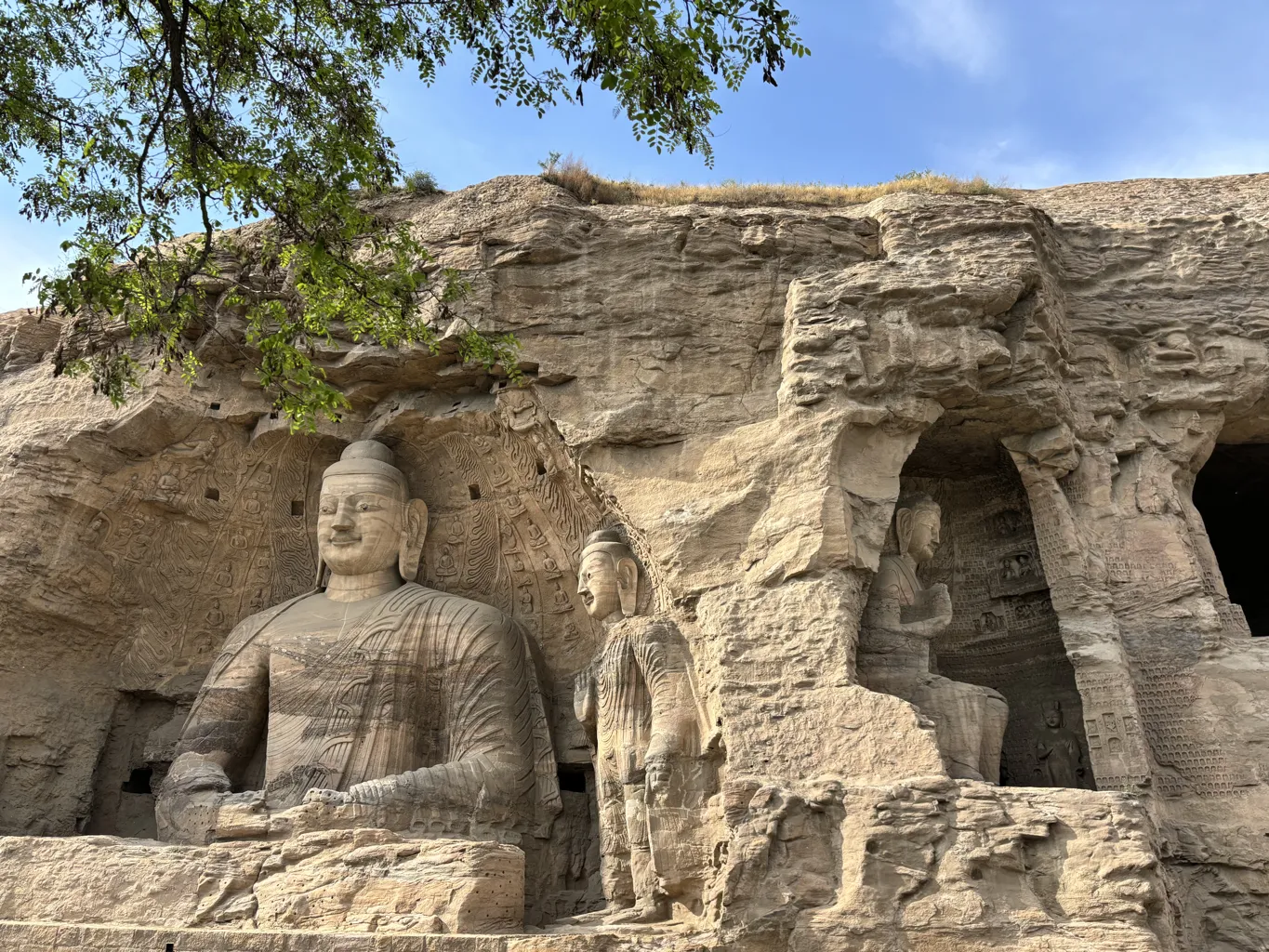
Representation and Symbolism
The robust and dignified appearance of the chief Buddha highlights the influence of the powerful nomadic tribe, the Xian Bei. This statue is not only a representative work of the sculptural art found in the Yungang Grottoes but also a masterpiece of early Buddhist sculptural art in China. Flanking the central Buddha are two standing Buddhas, although the one on the western side has unfortunately been ruined.
Despite the physical damage and historical vicissitudes, Cave No. 20 continues to stand as a testament to the rich cultural and artistic heritage of the Yungang Grottoes, embodying the spiritual and historical narratives that have shaped early Buddhist art in the region.
Sources:
Information directly from a visit at Yungang Grottoes from the Signage.

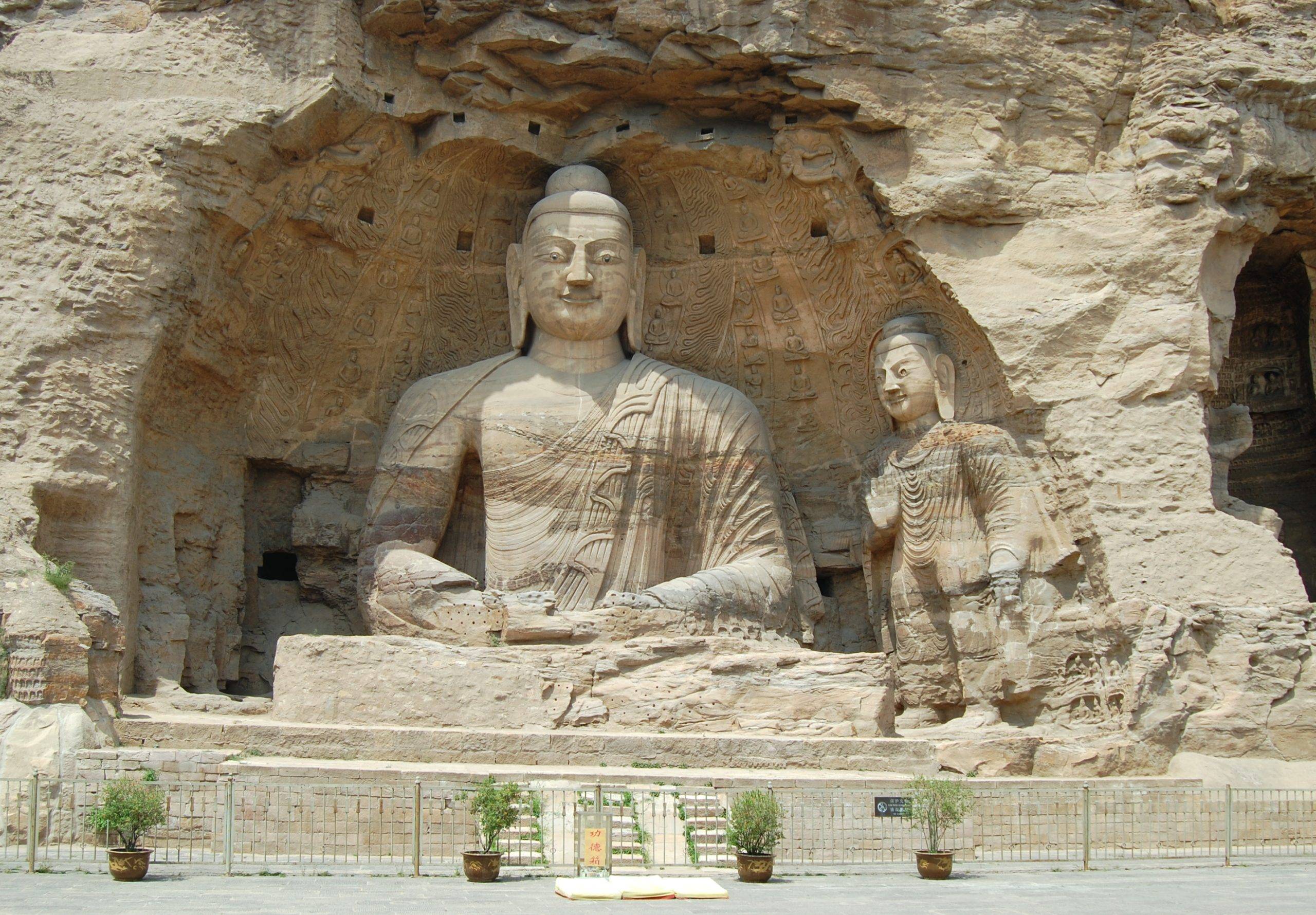
Gorgeous
Fantastic. Amazing! Thank you